(HIEU 164) - Women Missionaries
VerifiedAdded on 2023/07/07
|24
|4784
|99
AI Summary
This essay by Jason Baselyos discusses the experiences of women missionaries in Canada during the 17th century. Women's religious organizations sent missionaries to Canada out of a love for religion and a desire to increase the Catholic Church's power. These women showed tremendous resiliency and commitment despite encountering challenges such as illness risk, hostile local cultures, language hurdles, and difficult living conditions. They were instrumental in advancing education and women's emancipation, promoting cross-cultural understanding, enhancing trade, questioning conventional gender norms, and laying the groundwork for women's greater participation and influence in Canadian society. The essay also discusses the motivations for sending women missionaries and provides an example of a noteworthy female missionary, Marie de l'Incarnation.
Contribute Materials
Your contribution can guide someone’s learning journey. Share your
documents today.
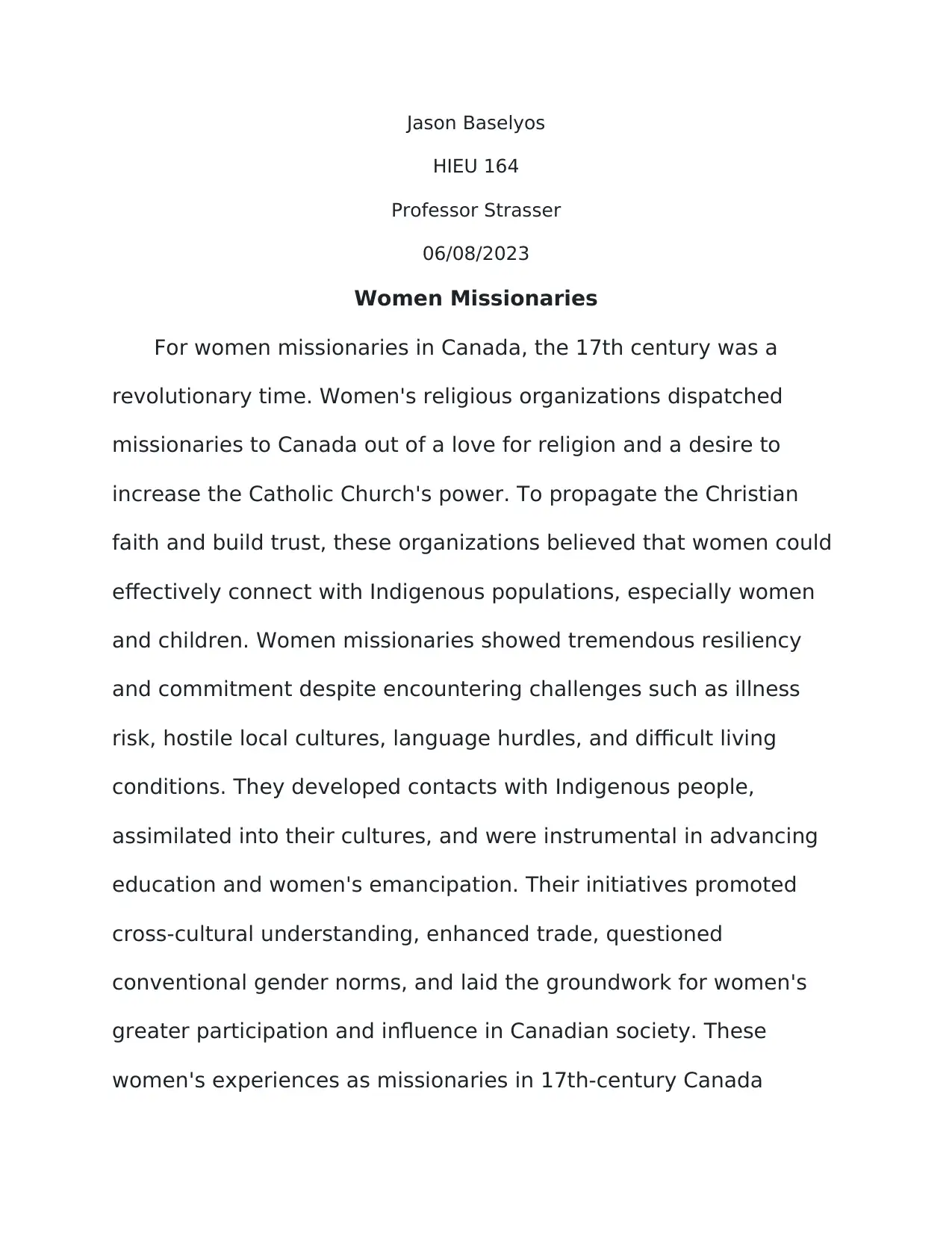
Jason Baselyos
HIEU 164
Professor Strasser
06/08/2023
Women Missionaries
For women missionaries in Canada, the 17th century was a
revolutionary time. Women's religious organizations dispatched
missionaries to Canada out of a love for religion and a desire to
increase the Catholic Church's power. To propagate the Christian
faith and build trust, these organizations believed that women could
effectively connect with Indigenous populations, especially women
and children. Women missionaries showed tremendous resiliency
and commitment despite encountering challenges such as illness
risk, hostile local cultures, language hurdles, and difficult living
conditions. They developed contacts with Indigenous people,
assimilated into their cultures, and were instrumental in advancing
education and women's emancipation. Their initiatives promoted
cross-cultural understanding, enhanced trade, questioned
conventional gender norms, and laid the groundwork for women's
greater participation and influence in Canadian society. These
women's experiences as missionaries in 17th-century Canada
HIEU 164
Professor Strasser
06/08/2023
Women Missionaries
For women missionaries in Canada, the 17th century was a
revolutionary time. Women's religious organizations dispatched
missionaries to Canada out of a love for religion and a desire to
increase the Catholic Church's power. To propagate the Christian
faith and build trust, these organizations believed that women could
effectively connect with Indigenous populations, especially women
and children. Women missionaries showed tremendous resiliency
and commitment despite encountering challenges such as illness
risk, hostile local cultures, language hurdles, and difficult living
conditions. They developed contacts with Indigenous people,
assimilated into their cultures, and were instrumental in advancing
education and women's emancipation. Their initiatives promoted
cross-cultural understanding, enhanced trade, questioned
conventional gender norms, and laid the groundwork for women's
greater participation and influence in Canadian society. These
women's experiences as missionaries in 17th-century Canada
Secure Best Marks with AI Grader
Need help grading? Try our AI Grader for instant feedback on your assignments.
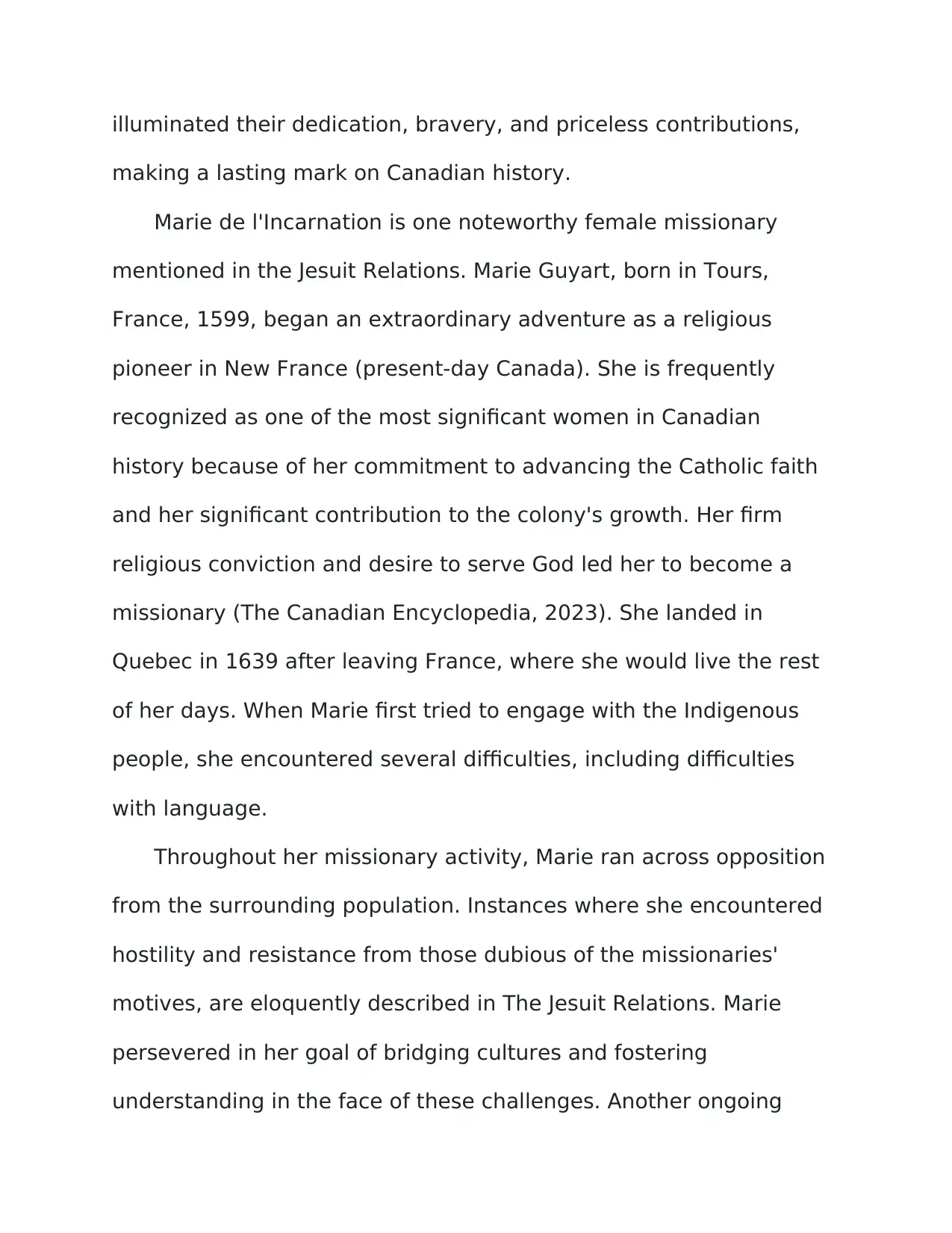
illuminated their dedication, bravery, and priceless contributions,
making a lasting mark on Canadian history.
Marie de l'Incarnation is one noteworthy female missionary
mentioned in the Jesuit Relations. Marie Guyart, born in Tours,
France, 1599, began an extraordinary adventure as a religious
pioneer in New France (present-day Canada). She is frequently
recognized as one of the most significant women in Canadian
history because of her commitment to advancing the Catholic faith
and her significant contribution to the colony's growth. Her firm
religious conviction and desire to serve God led her to become a
missionary (The Canadian Encyclopedia, 2023). She landed in
Quebec in 1639 after leaving France, where she would live the rest
of her days. When Marie first tried to engage with the Indigenous
people, she encountered several difficulties, including difficulties
with language.
Throughout her missionary activity, Marie ran across opposition
from the surrounding population. Instances where she encountered
hostility and resistance from those dubious of the missionaries'
motives, are eloquently described in The Jesuit Relations. Marie
persevered in her goal of bridging cultures and fostering
understanding in the face of these challenges. Another ongoing
making a lasting mark on Canadian history.
Marie de l'Incarnation is one noteworthy female missionary
mentioned in the Jesuit Relations. Marie Guyart, born in Tours,
France, 1599, began an extraordinary adventure as a religious
pioneer in New France (present-day Canada). She is frequently
recognized as one of the most significant women in Canadian
history because of her commitment to advancing the Catholic faith
and her significant contribution to the colony's growth. Her firm
religious conviction and desire to serve God led her to become a
missionary (The Canadian Encyclopedia, 2023). She landed in
Quebec in 1639 after leaving France, where she would live the rest
of her days. When Marie first tried to engage with the Indigenous
people, she encountered several difficulties, including difficulties
with language.
Throughout her missionary activity, Marie ran across opposition
from the surrounding population. Instances where she encountered
hostility and resistance from those dubious of the missionaries'
motives, are eloquently described in The Jesuit Relations. Marie
persevered in her goal of bridging cultures and fostering
understanding in the face of these challenges. Another ongoing
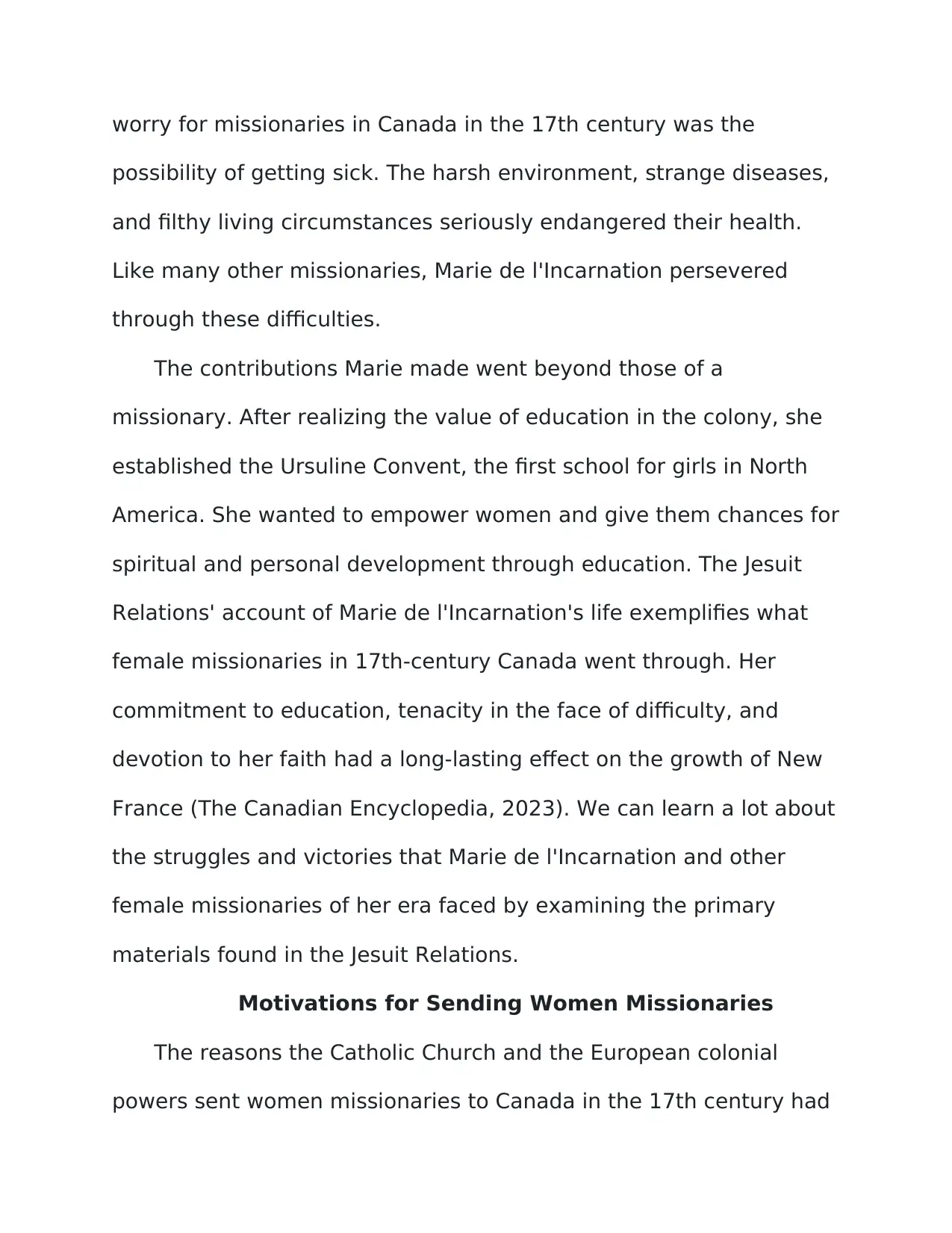
worry for missionaries in Canada in the 17th century was the
possibility of getting sick. The harsh environment, strange diseases,
and filthy living circumstances seriously endangered their health.
Like many other missionaries, Marie de l'Incarnation persevered
through these difficulties.
The contributions Marie made went beyond those of a
missionary. After realizing the value of education in the colony, she
established the Ursuline Convent, the first school for girls in North
America. She wanted to empower women and give them chances for
spiritual and personal development through education. The Jesuit
Relations' account of Marie de l'Incarnation's life exemplifies what
female missionaries in 17th-century Canada went through. Her
commitment to education, tenacity in the face of difficulty, and
devotion to her faith had a long-lasting effect on the growth of New
France (The Canadian Encyclopedia, 2023). We can learn a lot about
the struggles and victories that Marie de l'Incarnation and other
female missionaries of her era faced by examining the primary
materials found in the Jesuit Relations.
Motivations for Sending Women Missionaries
The reasons the Catholic Church and the European colonial
powers sent women missionaries to Canada in the 17th century had
possibility of getting sick. The harsh environment, strange diseases,
and filthy living circumstances seriously endangered their health.
Like many other missionaries, Marie de l'Incarnation persevered
through these difficulties.
The contributions Marie made went beyond those of a
missionary. After realizing the value of education in the colony, she
established the Ursuline Convent, the first school for girls in North
America. She wanted to empower women and give them chances for
spiritual and personal development through education. The Jesuit
Relations' account of Marie de l'Incarnation's life exemplifies what
female missionaries in 17th-century Canada went through. Her
commitment to education, tenacity in the face of difficulty, and
devotion to her faith had a long-lasting effect on the growth of New
France (The Canadian Encyclopedia, 2023). We can learn a lot about
the struggles and victories that Marie de l'Incarnation and other
female missionaries of her era faced by examining the primary
materials found in the Jesuit Relations.
Motivations for Sending Women Missionaries
The reasons the Catholic Church and the European colonial
powers sent women missionaries to Canada in the 17th century had
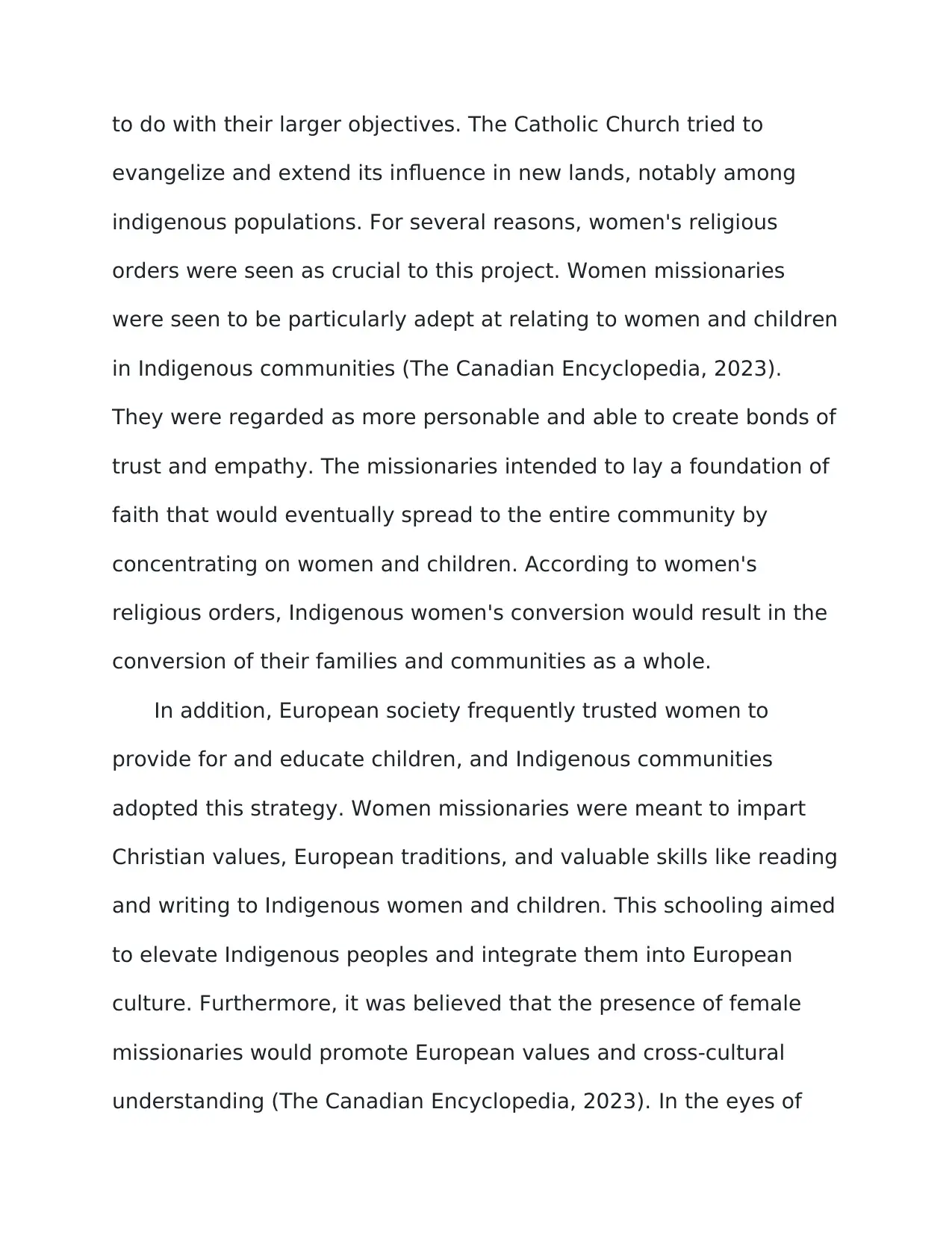
to do with their larger objectives. The Catholic Church tried to
evangelize and extend its influence in new lands, notably among
indigenous populations. For several reasons, women's religious
orders were seen as crucial to this project. Women missionaries
were seen to be particularly adept at relating to women and children
in Indigenous communities (The Canadian Encyclopedia, 2023).
They were regarded as more personable and able to create bonds of
trust and empathy. The missionaries intended to lay a foundation of
faith that would eventually spread to the entire community by
concentrating on women and children. According to women's
religious orders, Indigenous women's conversion would result in the
conversion of their families and communities as a whole.
In addition, European society frequently trusted women to
provide for and educate children, and Indigenous communities
adopted this strategy. Women missionaries were meant to impart
Christian values, European traditions, and valuable skills like reading
and writing to Indigenous women and children. This schooling aimed
to elevate Indigenous peoples and integrate them into European
culture. Furthermore, it was believed that the presence of female
missionaries would promote European values and cross-cultural
understanding (The Canadian Encyclopedia, 2023). In the eyes of
evangelize and extend its influence in new lands, notably among
indigenous populations. For several reasons, women's religious
orders were seen as crucial to this project. Women missionaries
were seen to be particularly adept at relating to women and children
in Indigenous communities (The Canadian Encyclopedia, 2023).
They were regarded as more personable and able to create bonds of
trust and empathy. The missionaries intended to lay a foundation of
faith that would eventually spread to the entire community by
concentrating on women and children. According to women's
religious orders, Indigenous women's conversion would result in the
conversion of their families and communities as a whole.
In addition, European society frequently trusted women to
provide for and educate children, and Indigenous communities
adopted this strategy. Women missionaries were meant to impart
Christian values, European traditions, and valuable skills like reading
and writing to Indigenous women and children. This schooling aimed
to elevate Indigenous peoples and integrate them into European
culture. Furthermore, it was believed that the presence of female
missionaries would promote European values and cross-cultural
understanding (The Canadian Encyclopedia, 2023). In the eyes of
Secure Best Marks with AI Grader
Need help grading? Try our AI Grader for instant feedback on your assignments.
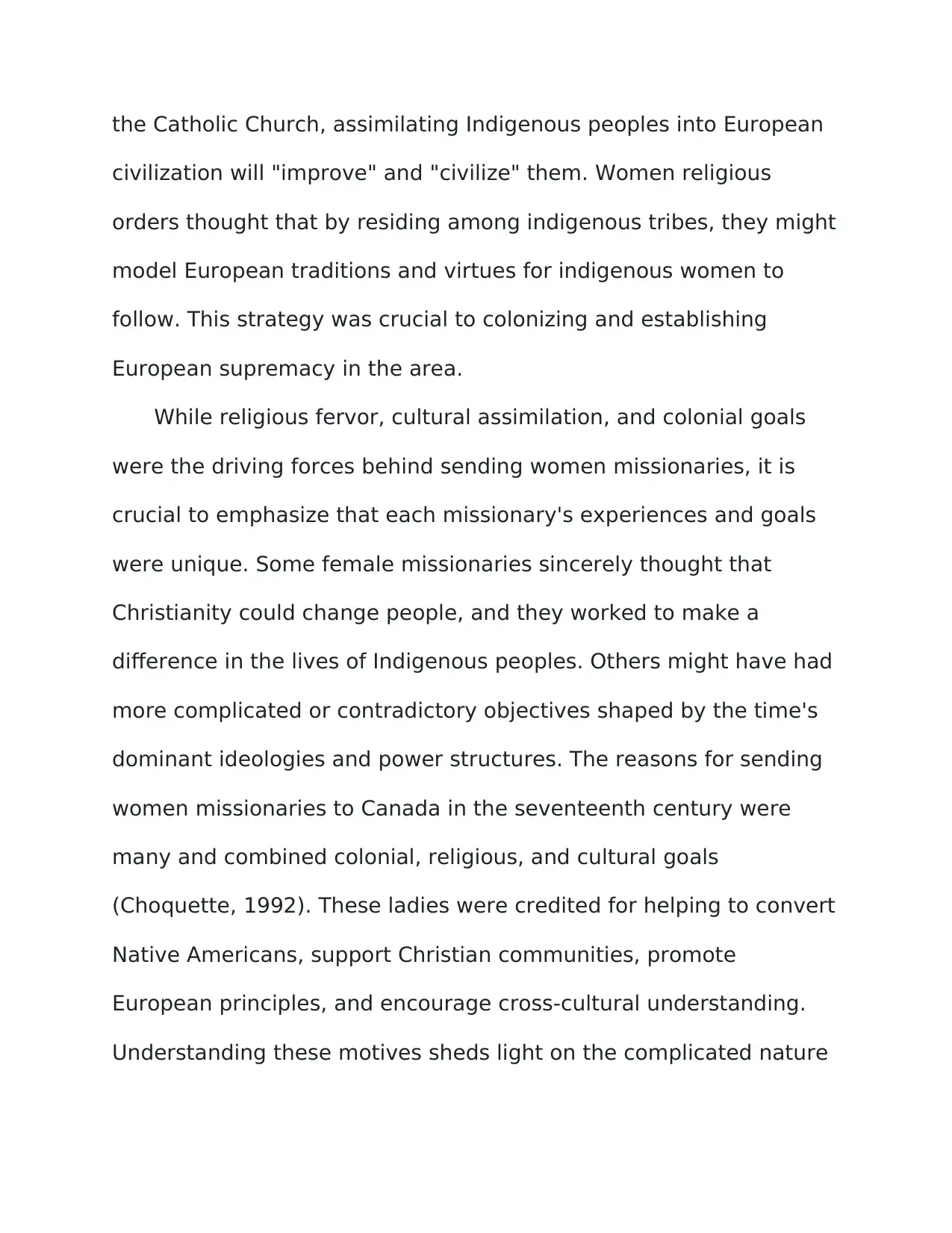
the Catholic Church, assimilating Indigenous peoples into European
civilization will "improve" and "civilize" them. Women religious
orders thought that by residing among indigenous tribes, they might
model European traditions and virtues for indigenous women to
follow. This strategy was crucial to colonizing and establishing
European supremacy in the area.
While religious fervor, cultural assimilation, and colonial goals
were the driving forces behind sending women missionaries, it is
crucial to emphasize that each missionary's experiences and goals
were unique. Some female missionaries sincerely thought that
Christianity could change people, and they worked to make a
difference in the lives of Indigenous peoples. Others might have had
more complicated or contradictory objectives shaped by the time's
dominant ideologies and power structures. The reasons for sending
women missionaries to Canada in the seventeenth century were
many and combined colonial, religious, and cultural goals
(Choquette, 1992). These ladies were credited for helping to convert
Native Americans, support Christian communities, promote
European principles, and encourage cross-cultural understanding.
Understanding these motives sheds light on the complicated nature
civilization will "improve" and "civilize" them. Women religious
orders thought that by residing among indigenous tribes, they might
model European traditions and virtues for indigenous women to
follow. This strategy was crucial to colonizing and establishing
European supremacy in the area.
While religious fervor, cultural assimilation, and colonial goals
were the driving forces behind sending women missionaries, it is
crucial to emphasize that each missionary's experiences and goals
were unique. Some female missionaries sincerely thought that
Christianity could change people, and they worked to make a
difference in the lives of Indigenous peoples. Others might have had
more complicated or contradictory objectives shaped by the time's
dominant ideologies and power structures. The reasons for sending
women missionaries to Canada in the seventeenth century were
many and combined colonial, religious, and cultural goals
(Choquette, 1992). These ladies were credited for helping to convert
Native Americans, support Christian communities, promote
European principles, and encourage cross-cultural understanding.
Understanding these motives sheds light on the complicated nature
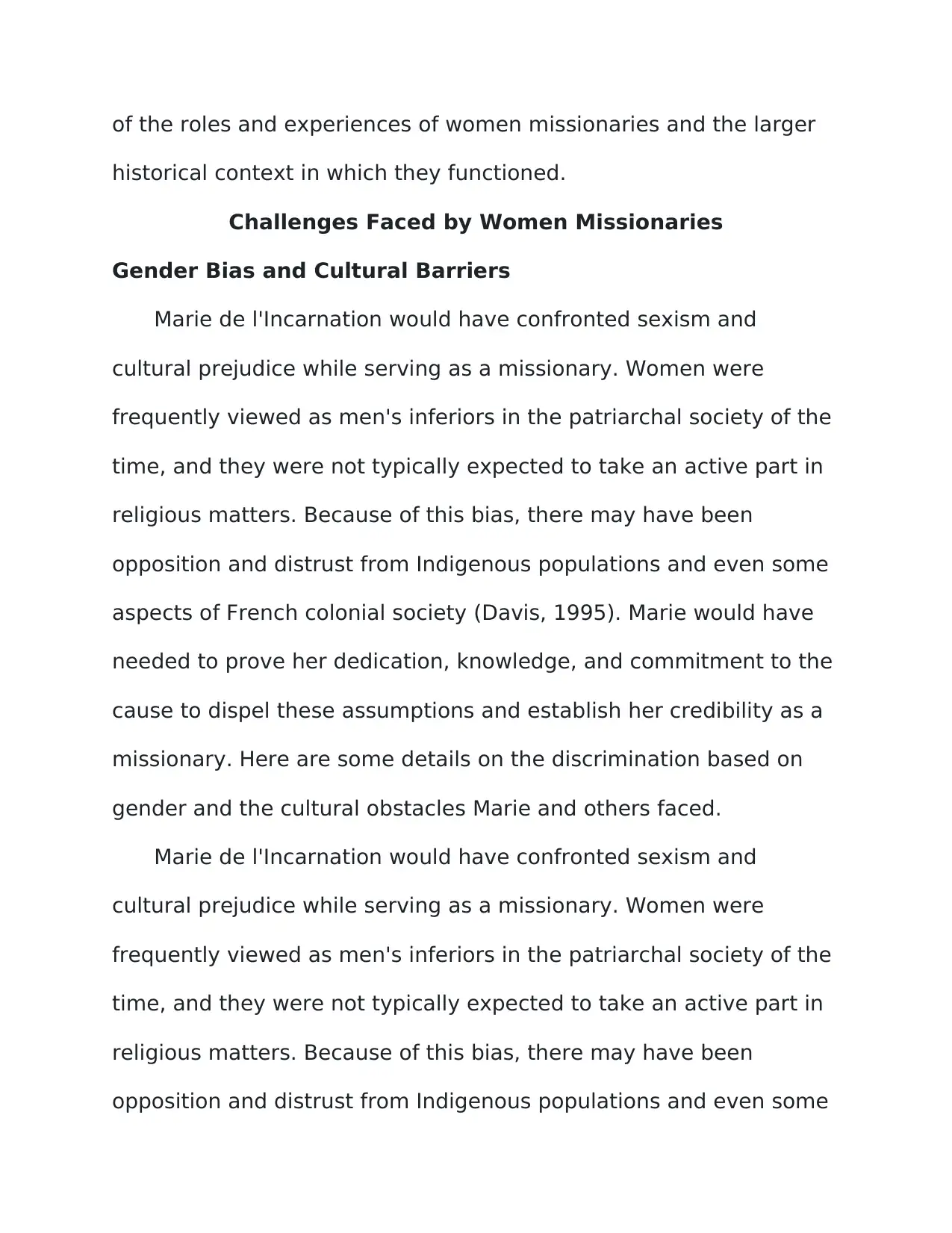
of the roles and experiences of women missionaries and the larger
historical context in which they functioned.
Challenges Faced by Women Missionaries
Gender Bias and Cultural Barriers
Marie de l'Incarnation would have confronted sexism and
cultural prejudice while serving as a missionary. Women were
frequently viewed as men's inferiors in the patriarchal society of the
time, and they were not typically expected to take an active part in
religious matters. Because of this bias, there may have been
opposition and distrust from Indigenous populations and even some
aspects of French colonial society (Davis, 1995). Marie would have
needed to prove her dedication, knowledge, and commitment to the
cause to dispel these assumptions and establish her credibility as a
missionary. Here are some details on the discrimination based on
gender and the cultural obstacles Marie and others faced.
Marie de l'Incarnation would have confronted sexism and
cultural prejudice while serving as a missionary. Women were
frequently viewed as men's inferiors in the patriarchal society of the
time, and they were not typically expected to take an active part in
religious matters. Because of this bias, there may have been
opposition and distrust from Indigenous populations and even some
historical context in which they functioned.
Challenges Faced by Women Missionaries
Gender Bias and Cultural Barriers
Marie de l'Incarnation would have confronted sexism and
cultural prejudice while serving as a missionary. Women were
frequently viewed as men's inferiors in the patriarchal society of the
time, and they were not typically expected to take an active part in
religious matters. Because of this bias, there may have been
opposition and distrust from Indigenous populations and even some
aspects of French colonial society (Davis, 1995). Marie would have
needed to prove her dedication, knowledge, and commitment to the
cause to dispel these assumptions and establish her credibility as a
missionary. Here are some details on the discrimination based on
gender and the cultural obstacles Marie and others faced.
Marie de l'Incarnation would have confronted sexism and
cultural prejudice while serving as a missionary. Women were
frequently viewed as men's inferiors in the patriarchal society of the
time, and they were not typically expected to take an active part in
religious matters. Because of this bias, there may have been
opposition and distrust from Indigenous populations and even some
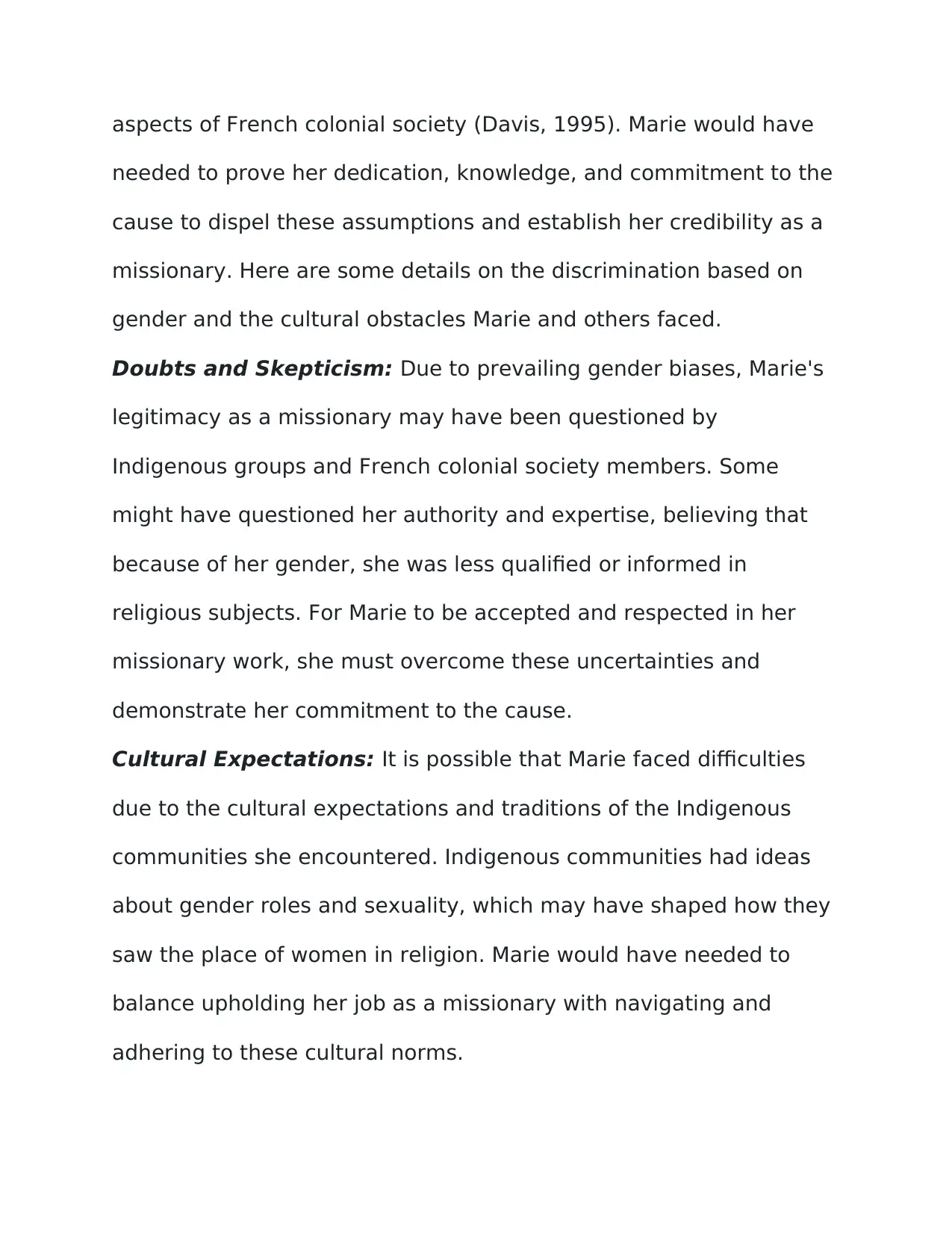
aspects of French colonial society (Davis, 1995). Marie would have
needed to prove her dedication, knowledge, and commitment to the
cause to dispel these assumptions and establish her credibility as a
missionary. Here are some details on the discrimination based on
gender and the cultural obstacles Marie and others faced.
Doubts and Skepticism: Due to prevailing gender biases, Marie's
legitimacy as a missionary may have been questioned by
Indigenous groups and French colonial society members. Some
might have questioned her authority and expertise, believing that
because of her gender, she was less qualified or informed in
religious subjects. For Marie to be accepted and respected in her
missionary work, she must overcome these uncertainties and
demonstrate her commitment to the cause.
Cultural Expectations: It is possible that Marie faced difficulties
due to the cultural expectations and traditions of the Indigenous
communities she encountered. Indigenous communities had ideas
about gender roles and sexuality, which may have shaped how they
saw the place of women in religion. Marie would have needed to
balance upholding her job as a missionary with navigating and
adhering to these cultural norms.
needed to prove her dedication, knowledge, and commitment to the
cause to dispel these assumptions and establish her credibility as a
missionary. Here are some details on the discrimination based on
gender and the cultural obstacles Marie and others faced.
Doubts and Skepticism: Due to prevailing gender biases, Marie's
legitimacy as a missionary may have been questioned by
Indigenous groups and French colonial society members. Some
might have questioned her authority and expertise, believing that
because of her gender, she was less qualified or informed in
religious subjects. For Marie to be accepted and respected in her
missionary work, she must overcome these uncertainties and
demonstrate her commitment to the cause.
Cultural Expectations: It is possible that Marie faced difficulties
due to the cultural expectations and traditions of the Indigenous
communities she encountered. Indigenous communities had ideas
about gender roles and sexuality, which may have shaped how they
saw the place of women in religion. Marie would have needed to
balance upholding her job as a missionary with navigating and
adhering to these cultural norms.
Paraphrase This Document
Need a fresh take? Get an instant paraphrase of this document with our AI Paraphraser
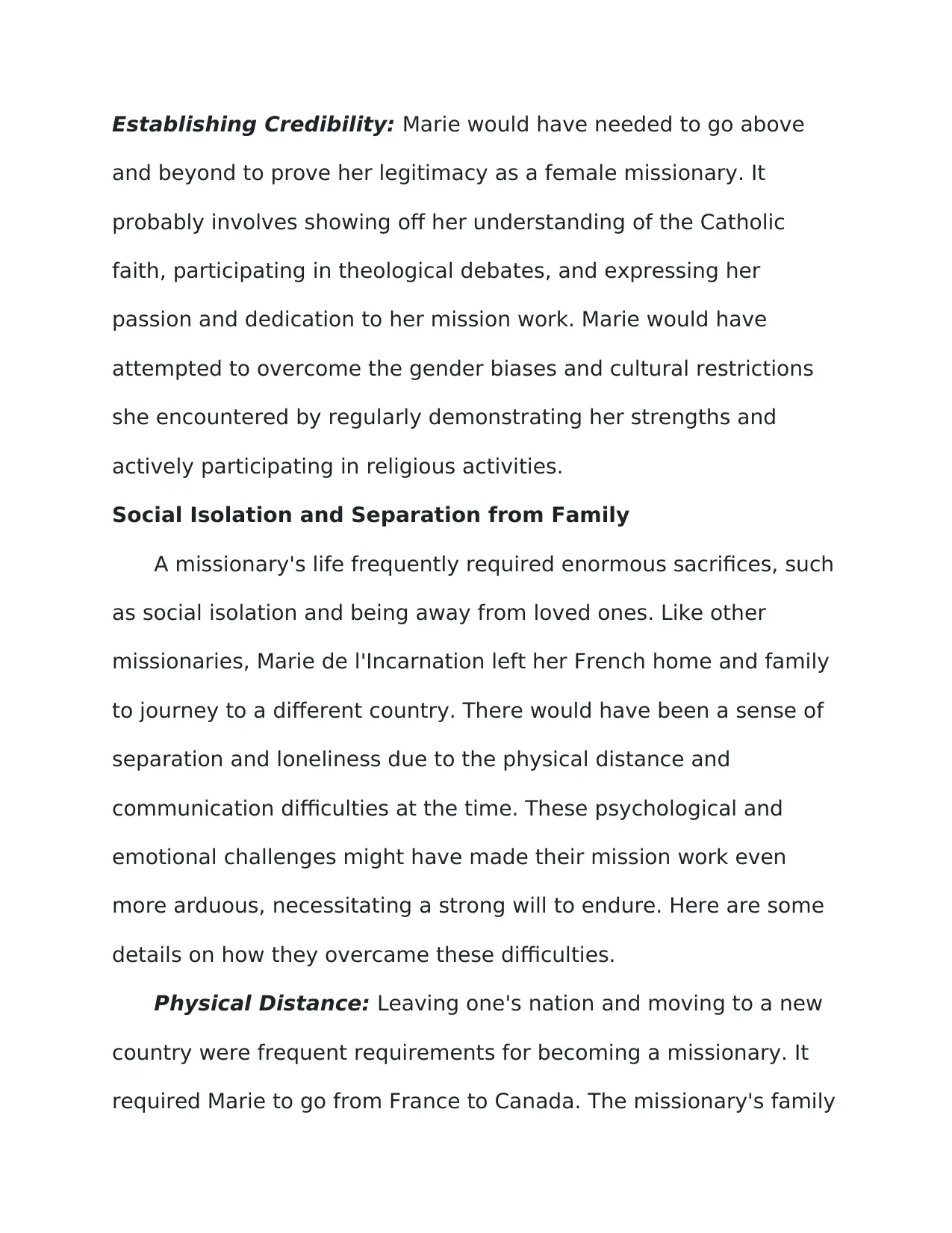
Establishing Credibility: Marie would have needed to go above
and beyond to prove her legitimacy as a female missionary. It
probably involves showing off her understanding of the Catholic
faith, participating in theological debates, and expressing her
passion and dedication to her mission work. Marie would have
attempted to overcome the gender biases and cultural restrictions
she encountered by regularly demonstrating her strengths and
actively participating in religious activities.
Social Isolation and Separation from Family
A missionary's life frequently required enormous sacrifices, such
as social isolation and being away from loved ones. Like other
missionaries, Marie de l'Incarnation left her French home and family
to journey to a different country. There would have been a sense of
separation and loneliness due to the physical distance and
communication difficulties at the time. These psychological and
emotional challenges might have made their mission work even
more arduous, necessitating a strong will to endure. Here are some
details on how they overcame these difficulties.
Physical Distance: Leaving one's nation and moving to a new
country were frequent requirements for becoming a missionary. It
required Marie to go from France to Canada. The missionary's family
and beyond to prove her legitimacy as a female missionary. It
probably involves showing off her understanding of the Catholic
faith, participating in theological debates, and expressing her
passion and dedication to her mission work. Marie would have
attempted to overcome the gender biases and cultural restrictions
she encountered by regularly demonstrating her strengths and
actively participating in religious activities.
Social Isolation and Separation from Family
A missionary's life frequently required enormous sacrifices, such
as social isolation and being away from loved ones. Like other
missionaries, Marie de l'Incarnation left her French home and family
to journey to a different country. There would have been a sense of
separation and loneliness due to the physical distance and
communication difficulties at the time. These psychological and
emotional challenges might have made their mission work even
more arduous, necessitating a strong will to endure. Here are some
details on how they overcame these difficulties.
Physical Distance: Leaving one's nation and moving to a new
country were frequent requirements for becoming a missionary. It
required Marie to go from France to Canada. The missionary's family
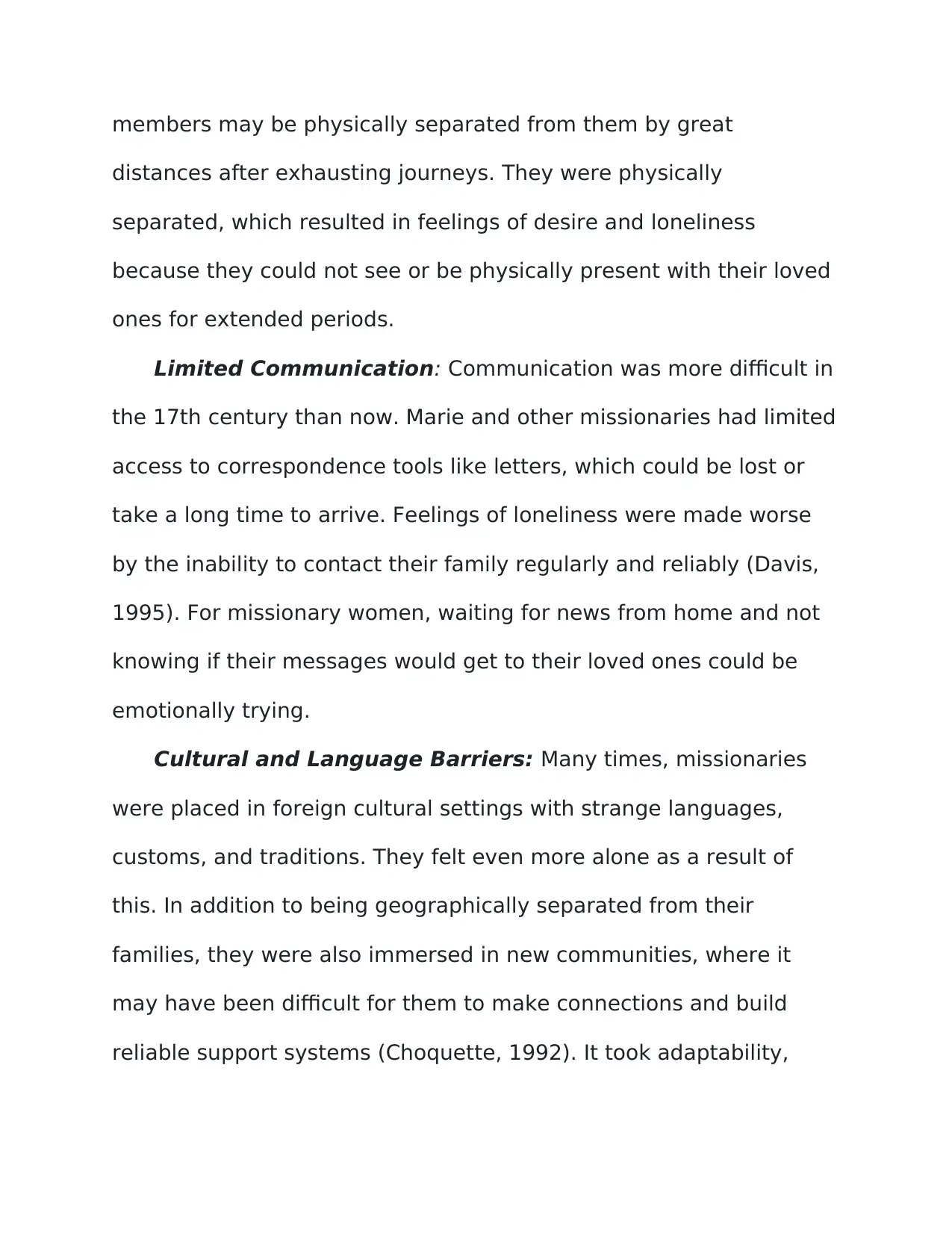
members may be physically separated from them by great
distances after exhausting journeys. They were physically
separated, which resulted in feelings of desire and loneliness
because they could not see or be physically present with their loved
ones for extended periods.
Limited Communication: Communication was more difficult in
the 17th century than now. Marie and other missionaries had limited
access to correspondence tools like letters, which could be lost or
take a long time to arrive. Feelings of loneliness were made worse
by the inability to contact their family regularly and reliably (Davis,
1995). For missionary women, waiting for news from home and not
knowing if their messages would get to their loved ones could be
emotionally trying.
Cultural and Language Barriers: Many times, missionaries
were placed in foreign cultural settings with strange languages,
customs, and traditions. They felt even more alone as a result of
this. In addition to being geographically separated from their
families, they were also immersed in new communities, where it
may have been difficult for them to make connections and build
reliable support systems (Choquette, 1992). It took adaptability,
distances after exhausting journeys. They were physically
separated, which resulted in feelings of desire and loneliness
because they could not see or be physically present with their loved
ones for extended periods.
Limited Communication: Communication was more difficult in
the 17th century than now. Marie and other missionaries had limited
access to correspondence tools like letters, which could be lost or
take a long time to arrive. Feelings of loneliness were made worse
by the inability to contact their family regularly and reliably (Davis,
1995). For missionary women, waiting for news from home and not
knowing if their messages would get to their loved ones could be
emotionally trying.
Cultural and Language Barriers: Many times, missionaries
were placed in foreign cultural settings with strange languages,
customs, and traditions. They felt even more alone as a result of
this. In addition to being geographically separated from their
families, they were also immersed in new communities, where it
may have been difficult for them to make connections and build
reliable support systems (Choquette, 1992). It took adaptability,
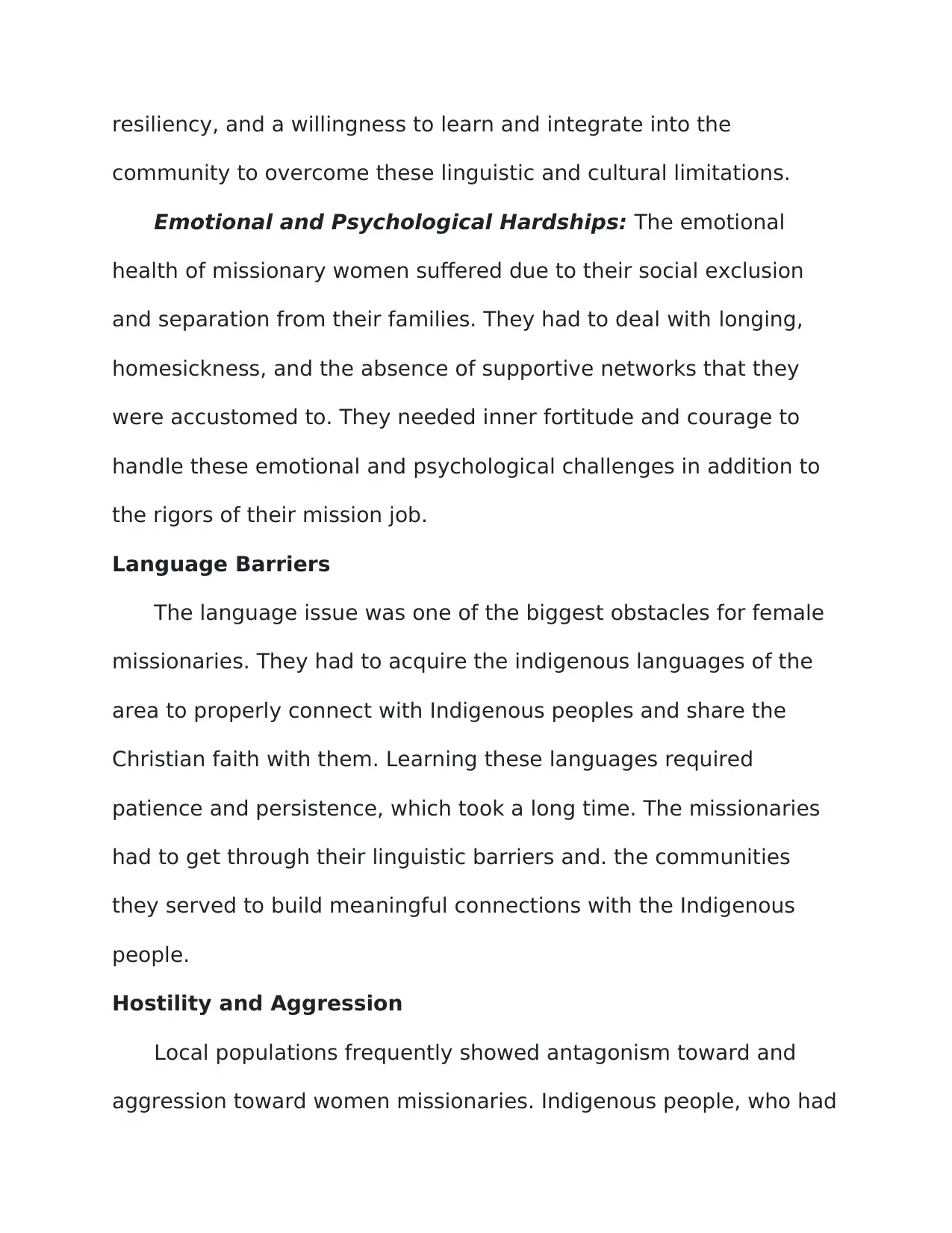
resiliency, and a willingness to learn and integrate into the
community to overcome these linguistic and cultural limitations.
Emotional and Psychological Hardships: The emotional
health of missionary women suffered due to their social exclusion
and separation from their families. They had to deal with longing,
homesickness, and the absence of supportive networks that they
were accustomed to. They needed inner fortitude and courage to
handle these emotional and psychological challenges in addition to
the rigors of their mission job.
Language Barriers
The language issue was one of the biggest obstacles for female
missionaries. They had to acquire the indigenous languages of the
area to properly connect with Indigenous peoples and share the
Christian faith with them. Learning these languages required
patience and persistence, which took a long time. The missionaries
had to get through their linguistic barriers and. the communities
they served to build meaningful connections with the Indigenous
people.
Hostility and Aggression
Local populations frequently showed antagonism toward and
aggression toward women missionaries. Indigenous people, who had
community to overcome these linguistic and cultural limitations.
Emotional and Psychological Hardships: The emotional
health of missionary women suffered due to their social exclusion
and separation from their families. They had to deal with longing,
homesickness, and the absence of supportive networks that they
were accustomed to. They needed inner fortitude and courage to
handle these emotional and psychological challenges in addition to
the rigors of their mission job.
Language Barriers
The language issue was one of the biggest obstacles for female
missionaries. They had to acquire the indigenous languages of the
area to properly connect with Indigenous peoples and share the
Christian faith with them. Learning these languages required
patience and persistence, which took a long time. The missionaries
had to get through their linguistic barriers and. the communities
they served to build meaningful connections with the Indigenous
people.
Hostility and Aggression
Local populations frequently showed antagonism toward and
aggression toward women missionaries. Indigenous people, who had
Secure Best Marks with AI Grader
Need help grading? Try our AI Grader for instant feedback on your assignments.
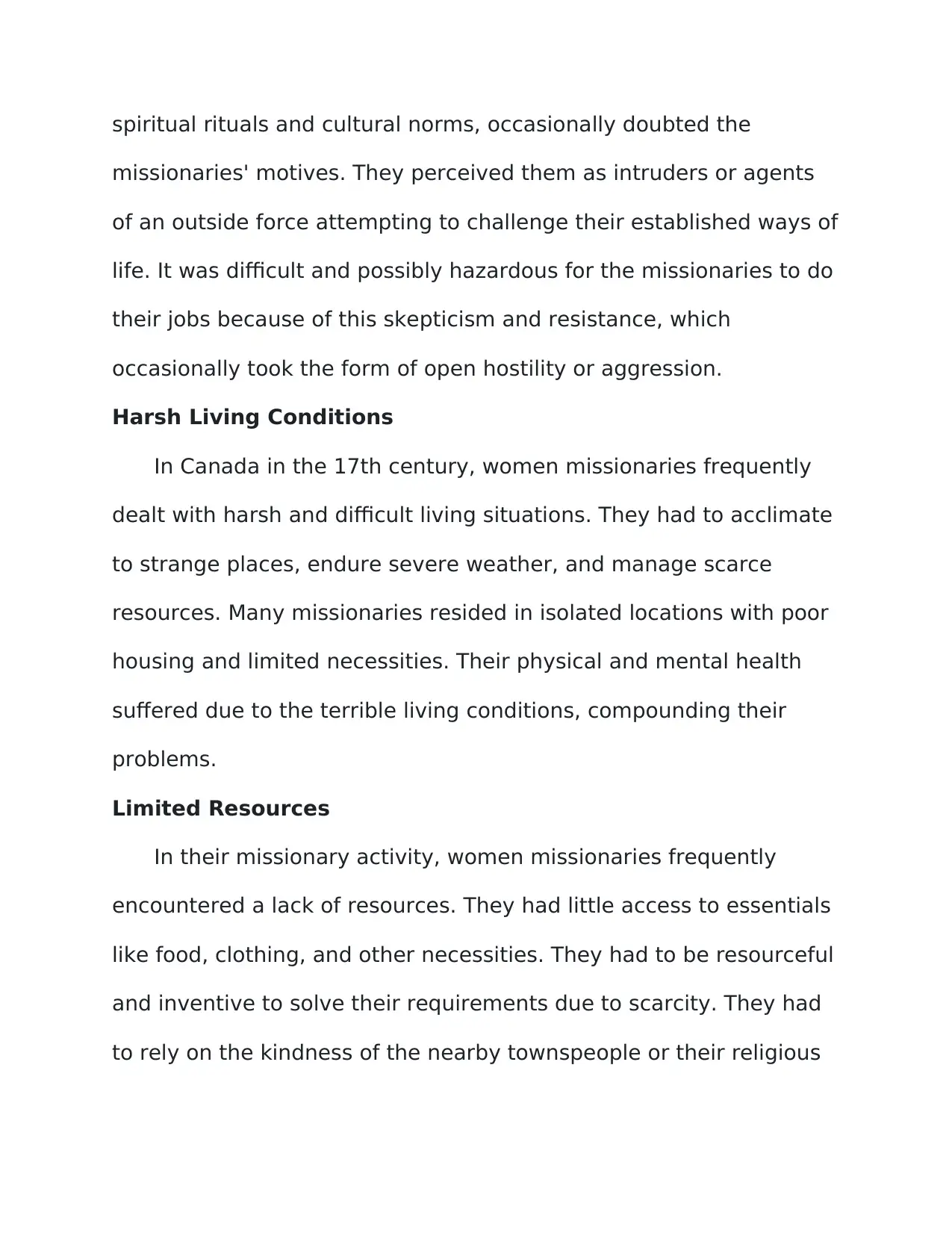
spiritual rituals and cultural norms, occasionally doubted the
missionaries' motives. They perceived them as intruders or agents
of an outside force attempting to challenge their established ways of
life. It was difficult and possibly hazardous for the missionaries to do
their jobs because of this skepticism and resistance, which
occasionally took the form of open hostility or aggression.
Harsh Living Conditions
In Canada in the 17th century, women missionaries frequently
dealt with harsh and difficult living situations. They had to acclimate
to strange places, endure severe weather, and manage scarce
resources. Many missionaries resided in isolated locations with poor
housing and limited necessities. Their physical and mental health
suffered due to the terrible living conditions, compounding their
problems.
Limited Resources
In their missionary activity, women missionaries frequently
encountered a lack of resources. They had little access to essentials
like food, clothing, and other necessities. They had to be resourceful
and inventive to solve their requirements due to scarcity. They had
to rely on the kindness of the nearby townspeople or their religious
missionaries' motives. They perceived them as intruders or agents
of an outside force attempting to challenge their established ways of
life. It was difficult and possibly hazardous for the missionaries to do
their jobs because of this skepticism and resistance, which
occasionally took the form of open hostility or aggression.
Harsh Living Conditions
In Canada in the 17th century, women missionaries frequently
dealt with harsh and difficult living situations. They had to acclimate
to strange places, endure severe weather, and manage scarce
resources. Many missionaries resided in isolated locations with poor
housing and limited necessities. Their physical and mental health
suffered due to the terrible living conditions, compounding their
problems.
Limited Resources
In their missionary activity, women missionaries frequently
encountered a lack of resources. They had little access to essentials
like food, clothing, and other necessities. They had to be resourceful
and inventive to solve their requirements due to scarcity. They had
to rely on the kindness of the nearby townspeople or their religious
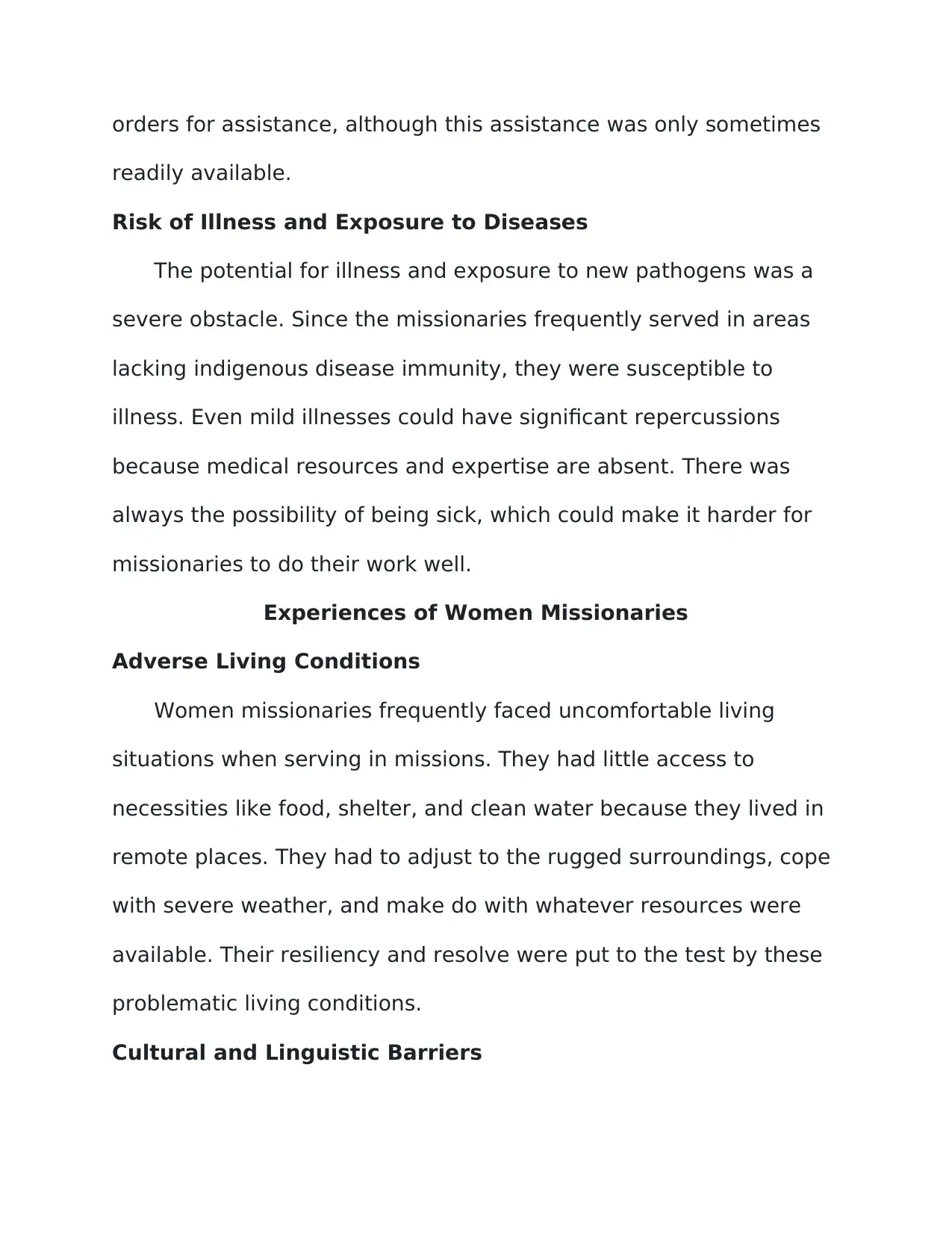
orders for assistance, although this assistance was only sometimes
readily available.
Risk of Illness and Exposure to Diseases
The potential for illness and exposure to new pathogens was a
severe obstacle. Since the missionaries frequently served in areas
lacking indigenous disease immunity, they were susceptible to
illness. Even mild illnesses could have significant repercussions
because medical resources and expertise are absent. There was
always the possibility of being sick, which could make it harder for
missionaries to do their work well.
Experiences of Women Missionaries
Adverse Living Conditions
Women missionaries frequently faced uncomfortable living
situations when serving in missions. They had little access to
necessities like food, shelter, and clean water because they lived in
remote places. They had to adjust to the rugged surroundings, cope
with severe weather, and make do with whatever resources were
available. Their resiliency and resolve were put to the test by these
problematic living conditions.
Cultural and Linguistic Barriers
readily available.
Risk of Illness and Exposure to Diseases
The potential for illness and exposure to new pathogens was a
severe obstacle. Since the missionaries frequently served in areas
lacking indigenous disease immunity, they were susceptible to
illness. Even mild illnesses could have significant repercussions
because medical resources and expertise are absent. There was
always the possibility of being sick, which could make it harder for
missionaries to do their work well.
Experiences of Women Missionaries
Adverse Living Conditions
Women missionaries frequently faced uncomfortable living
situations when serving in missions. They had little access to
necessities like food, shelter, and clean water because they lived in
remote places. They had to adjust to the rugged surroundings, cope
with severe weather, and make do with whatever resources were
available. Their resiliency and resolve were put to the test by these
problematic living conditions.
Cultural and Linguistic Barriers
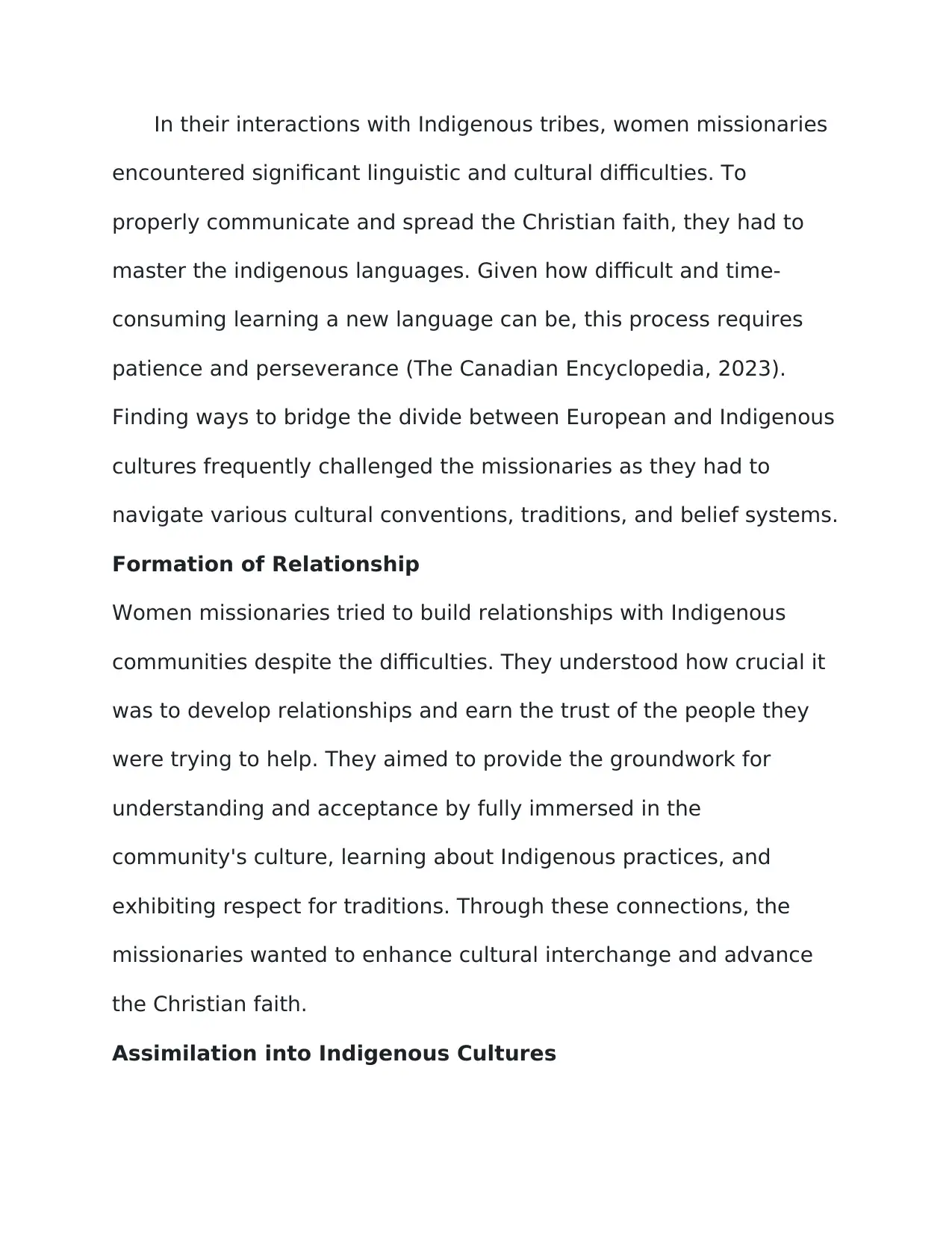
In their interactions with Indigenous tribes, women missionaries
encountered significant linguistic and cultural difficulties. To
properly communicate and spread the Christian faith, they had to
master the indigenous languages. Given how difficult and time-
consuming learning a new language can be, this process requires
patience and perseverance (The Canadian Encyclopedia, 2023).
Finding ways to bridge the divide between European and Indigenous
cultures frequently challenged the missionaries as they had to
navigate various cultural conventions, traditions, and belief systems.
Formation of Relationship
Women missionaries tried to build relationships with Indigenous
communities despite the difficulties. They understood how crucial it
was to develop relationships and earn the trust of the people they
were trying to help. They aimed to provide the groundwork for
understanding and acceptance by fully immersed in the
community's culture, learning about Indigenous practices, and
exhibiting respect for traditions. Through these connections, the
missionaries wanted to enhance cultural interchange and advance
the Christian faith.
Assimilation into Indigenous Cultures
encountered significant linguistic and cultural difficulties. To
properly communicate and spread the Christian faith, they had to
master the indigenous languages. Given how difficult and time-
consuming learning a new language can be, this process requires
patience and perseverance (The Canadian Encyclopedia, 2023).
Finding ways to bridge the divide between European and Indigenous
cultures frequently challenged the missionaries as they had to
navigate various cultural conventions, traditions, and belief systems.
Formation of Relationship
Women missionaries tried to build relationships with Indigenous
communities despite the difficulties. They understood how crucial it
was to develop relationships and earn the trust of the people they
were trying to help. They aimed to provide the groundwork for
understanding and acceptance by fully immersed in the
community's culture, learning about Indigenous practices, and
exhibiting respect for traditions. Through these connections, the
missionaries wanted to enhance cultural interchange and advance
the Christian faith.
Assimilation into Indigenous Cultures
Paraphrase This Document
Need a fresh take? Get an instant paraphrase of this document with our AI Paraphraser
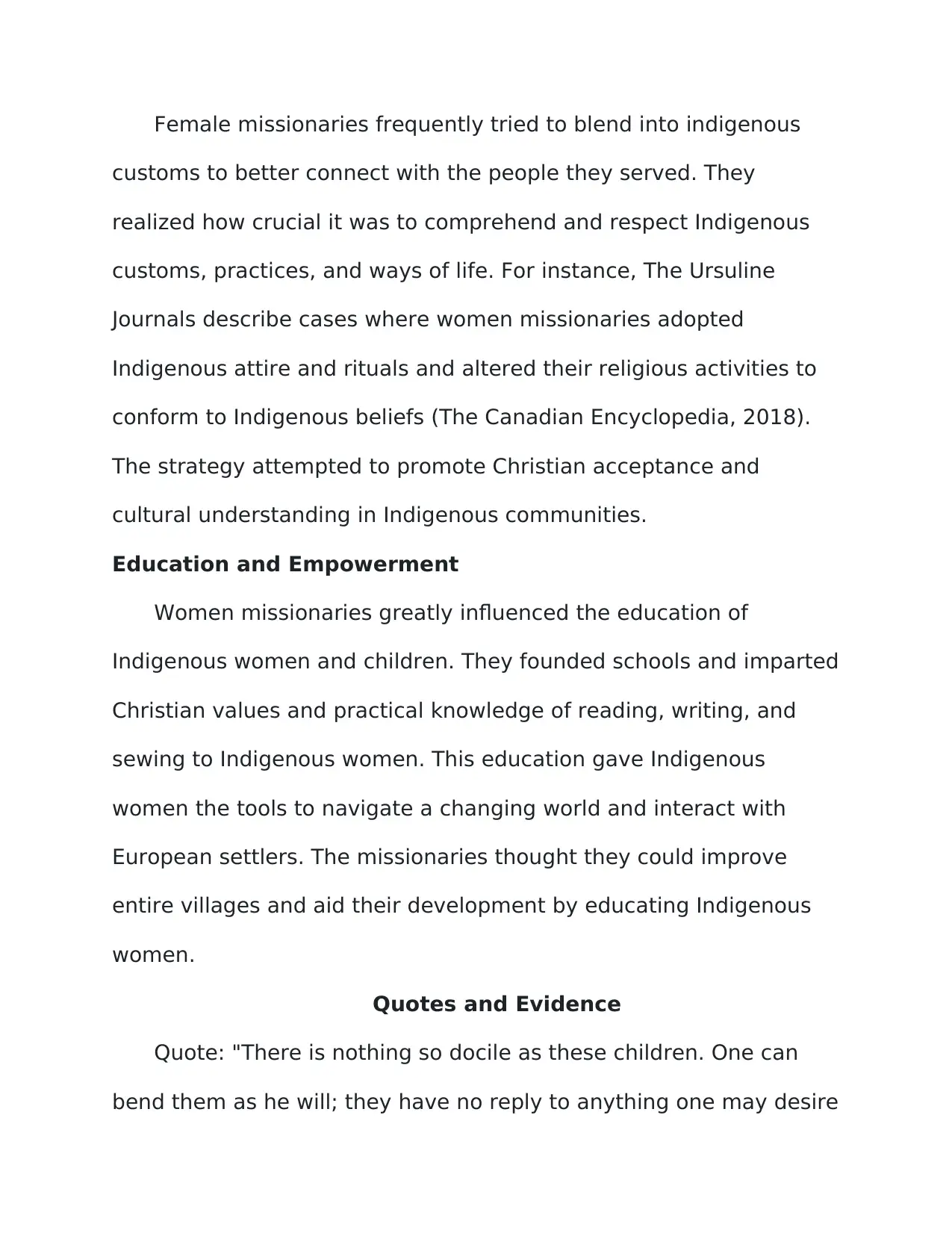
Female missionaries frequently tried to blend into indigenous
customs to better connect with the people they served. They
realized how crucial it was to comprehend and respect Indigenous
customs, practices, and ways of life. For instance, The Ursuline
Journals describe cases where women missionaries adopted
Indigenous attire and rituals and altered their religious activities to
conform to Indigenous beliefs (The Canadian Encyclopedia, 2018).
The strategy attempted to promote Christian acceptance and
cultural understanding in Indigenous communities.
Education and Empowerment
Women missionaries greatly influenced the education of
Indigenous women and children. They founded schools and imparted
Christian values and practical knowledge of reading, writing, and
sewing to Indigenous women. This education gave Indigenous
women the tools to navigate a changing world and interact with
European settlers. The missionaries thought they could improve
entire villages and aid their development by educating Indigenous
women.
Quotes and Evidence
Quote: "There is nothing so docile as these children. One can
bend them as he will; they have no reply to anything one may desire
customs to better connect with the people they served. They
realized how crucial it was to comprehend and respect Indigenous
customs, practices, and ways of life. For instance, The Ursuline
Journals describe cases where women missionaries adopted
Indigenous attire and rituals and altered their religious activities to
conform to Indigenous beliefs (The Canadian Encyclopedia, 2018).
The strategy attempted to promote Christian acceptance and
cultural understanding in Indigenous communities.
Education and Empowerment
Women missionaries greatly influenced the education of
Indigenous women and children. They founded schools and imparted
Christian values and practical knowledge of reading, writing, and
sewing to Indigenous women. This education gave Indigenous
women the tools to navigate a changing world and interact with
European settlers. The missionaries thought they could improve
entire villages and aid their development by educating Indigenous
women.
Quotes and Evidence
Quote: "There is nothing so docile as these children. One can
bend them as he will; they have no reply to anything one may desire
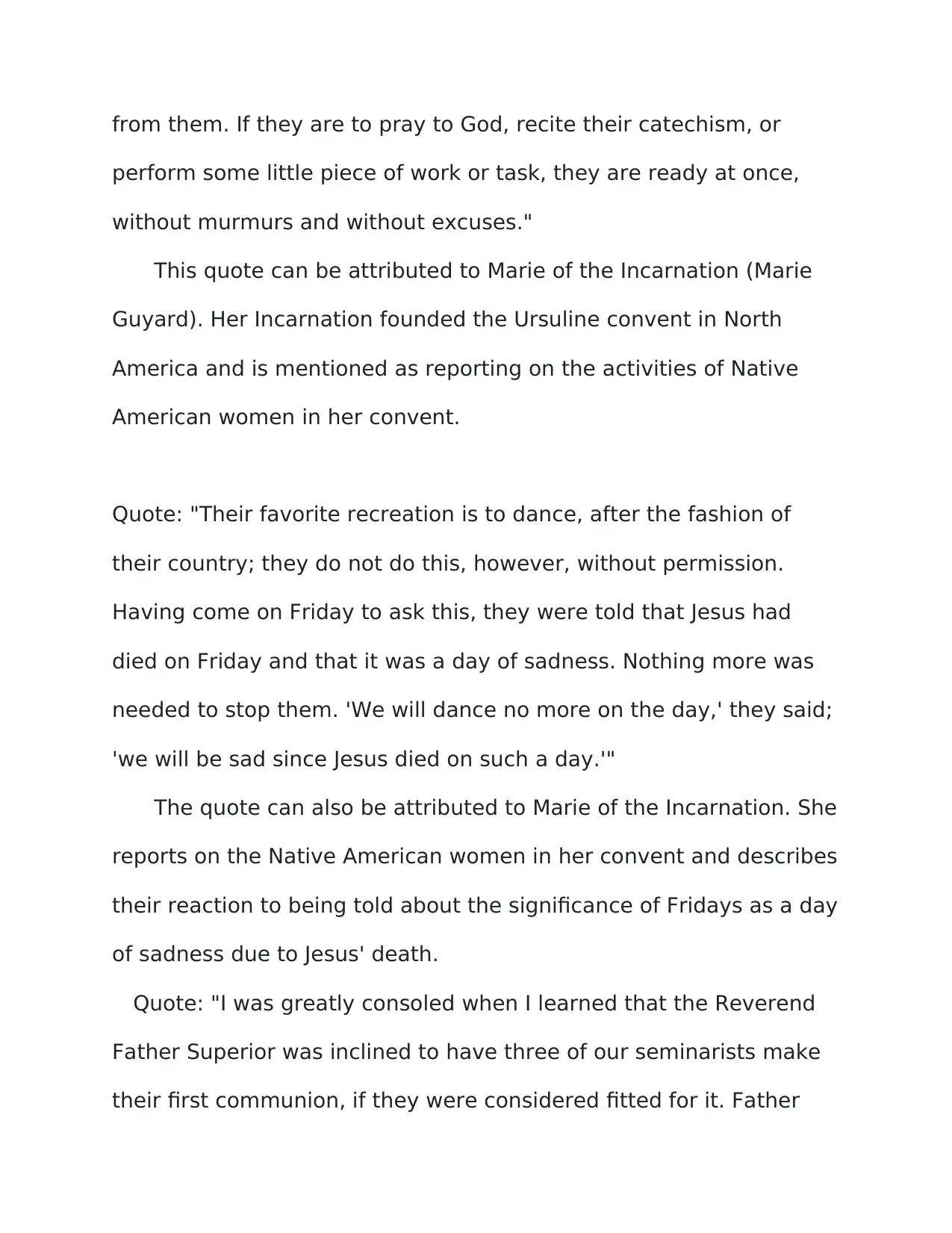
from them. If they are to pray to God, recite their catechism, or
perform some little piece of work or task, they are ready at once,
without murmurs and without excuses."
This quote can be attributed to Marie of the Incarnation (Marie
Guyard). Her Incarnation founded the Ursuline convent in North
America and is mentioned as reporting on the activities of Native
American women in her convent.
Quote: "Their favorite recreation is to dance, after the fashion of
their country; they do not do this, however, without permission.
Having come on Friday to ask this, they were told that Jesus had
died on Friday and that it was a day of sadness. Nothing more was
needed to stop them. 'We will dance no more on the day,' they said;
'we will be sad since Jesus died on such a day.'"
The quote can also be attributed to Marie of the Incarnation. She
reports on the Native American women in her convent and describes
their reaction to being told about the significance of Fridays as a day
of sadness due to Jesus' death.
Quote: "I was greatly consoled when I learned that the Reverend
Father Superior was inclined to have three of our seminarists make
their first communion, if they were considered fitted for it. Father
perform some little piece of work or task, they are ready at once,
without murmurs and without excuses."
This quote can be attributed to Marie of the Incarnation (Marie
Guyard). Her Incarnation founded the Ursuline convent in North
America and is mentioned as reporting on the activities of Native
American women in her convent.
Quote: "Their favorite recreation is to dance, after the fashion of
their country; they do not do this, however, without permission.
Having come on Friday to ask this, they were told that Jesus had
died on Friday and that it was a day of sadness. Nothing more was
needed to stop them. 'We will dance no more on the day,' they said;
'we will be sad since Jesus died on such a day.'"
The quote can also be attributed to Marie of the Incarnation. She
reports on the Native American women in her convent and describes
their reaction to being told about the significance of Fridays as a day
of sadness due to Jesus' death.
Quote: "I was greatly consoled when I learned that the Reverend
Father Superior was inclined to have three of our seminarists make
their first communion, if they were considered fitted for it. Father
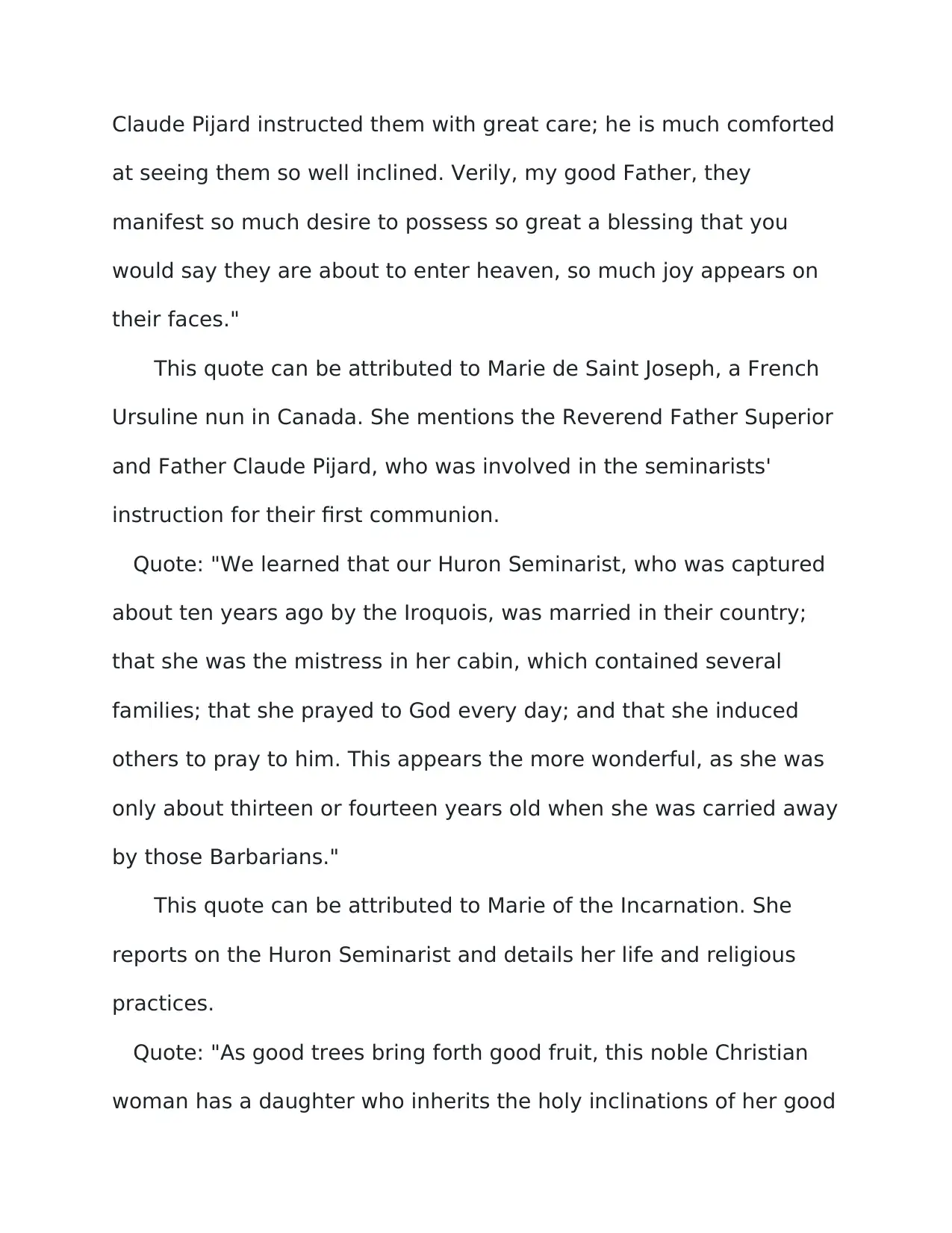
Claude Pijard instructed them with great care; he is much comforted
at seeing them so well inclined. Verily, my good Father, they
manifest so much desire to possess so great a blessing that you
would say they are about to enter heaven, so much joy appears on
their faces."
This quote can be attributed to Marie de Saint Joseph, a French
Ursuline nun in Canada. She mentions the Reverend Father Superior
and Father Claude Pijard, who was involved in the seminarists'
instruction for their first communion.
Quote: "We learned that our Huron Seminarist, who was captured
about ten years ago by the Iroquois, was married in their country;
that she was the mistress in her cabin, which contained several
families; that she prayed to God every day; and that she induced
others to pray to him. This appears the more wonderful, as she was
only about thirteen or fourteen years old when she was carried away
by those Barbarians."
This quote can be attributed to Marie of the Incarnation. She
reports on the Huron Seminarist and details her life and religious
practices.
Quote: "As good trees bring forth good fruit, this noble Christian
woman has a daughter who inherits the holy inclinations of her good
at seeing them so well inclined. Verily, my good Father, they
manifest so much desire to possess so great a blessing that you
would say they are about to enter heaven, so much joy appears on
their faces."
This quote can be attributed to Marie de Saint Joseph, a French
Ursuline nun in Canada. She mentions the Reverend Father Superior
and Father Claude Pijard, who was involved in the seminarists'
instruction for their first communion.
Quote: "We learned that our Huron Seminarist, who was captured
about ten years ago by the Iroquois, was married in their country;
that she was the mistress in her cabin, which contained several
families; that she prayed to God every day; and that she induced
others to pray to him. This appears the more wonderful, as she was
only about thirteen or fourteen years old when she was carried away
by those Barbarians."
This quote can be attributed to Marie of the Incarnation. She
reports on the Huron Seminarist and details her life and religious
practices.
Quote: "As good trees bring forth good fruit, this noble Christian
woman has a daughter who inherits the holy inclinations of her good
Secure Best Marks with AI Grader
Need help grading? Try our AI Grader for instant feedback on your assignments.
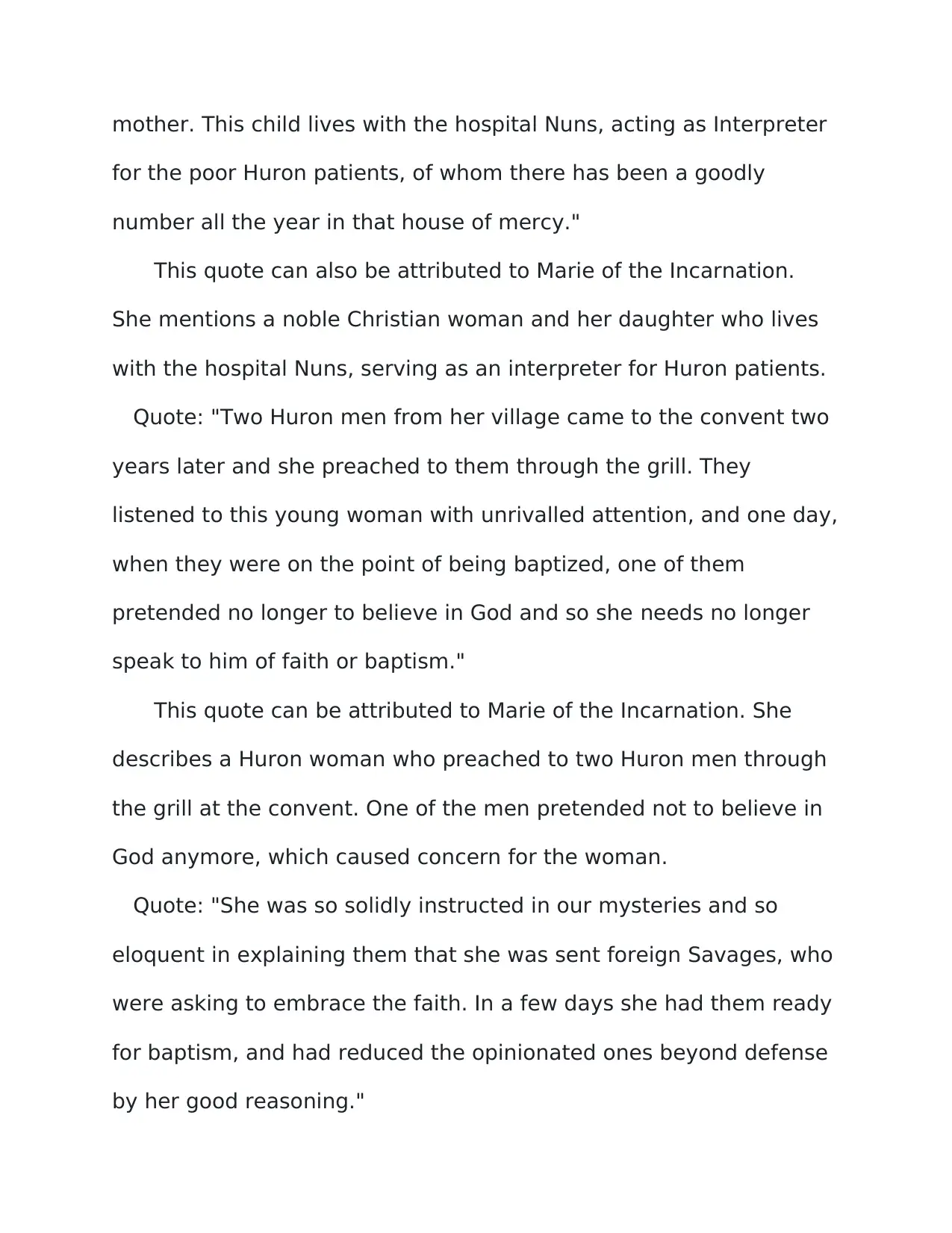
mother. This child lives with the hospital Nuns, acting as Interpreter
for the poor Huron patients, of whom there has been a goodly
number all the year in that house of mercy."
This quote can also be attributed to Marie of the Incarnation.
She mentions a noble Christian woman and her daughter who lives
with the hospital Nuns, serving as an interpreter for Huron patients.
Quote: "Two Huron men from her village came to the convent two
years later and she preached to them through the grill. They
listened to this young woman with unrivalled attention, and one day,
when they were on the point of being baptized, one of them
pretended no longer to believe in God and so she needs no longer
speak to him of faith or baptism."
This quote can be attributed to Marie of the Incarnation. She
describes a Huron woman who preached to two Huron men through
the grill at the convent. One of the men pretended not to believe in
God anymore, which caused concern for the woman.
Quote: "She was so solidly instructed in our mysteries and so
eloquent in explaining them that she was sent foreign Savages, who
were asking to embrace the faith. In a few days she had them ready
for baptism, and had reduced the opinionated ones beyond defense
by her good reasoning."
for the poor Huron patients, of whom there has been a goodly
number all the year in that house of mercy."
This quote can also be attributed to Marie of the Incarnation.
She mentions a noble Christian woman and her daughter who lives
with the hospital Nuns, serving as an interpreter for Huron patients.
Quote: "Two Huron men from her village came to the convent two
years later and she preached to them through the grill. They
listened to this young woman with unrivalled attention, and one day,
when they were on the point of being baptized, one of them
pretended no longer to believe in God and so she needs no longer
speak to him of faith or baptism."
This quote can be attributed to Marie of the Incarnation. She
describes a Huron woman who preached to two Huron men through
the grill at the convent. One of the men pretended not to believe in
God anymore, which caused concern for the woman.
Quote: "She was so solidly instructed in our mysteries and so
eloquent in explaining them that she was sent foreign Savages, who
were asking to embrace the faith. In a few days she had them ready
for baptism, and had reduced the opinionated ones beyond defense
by her good reasoning."
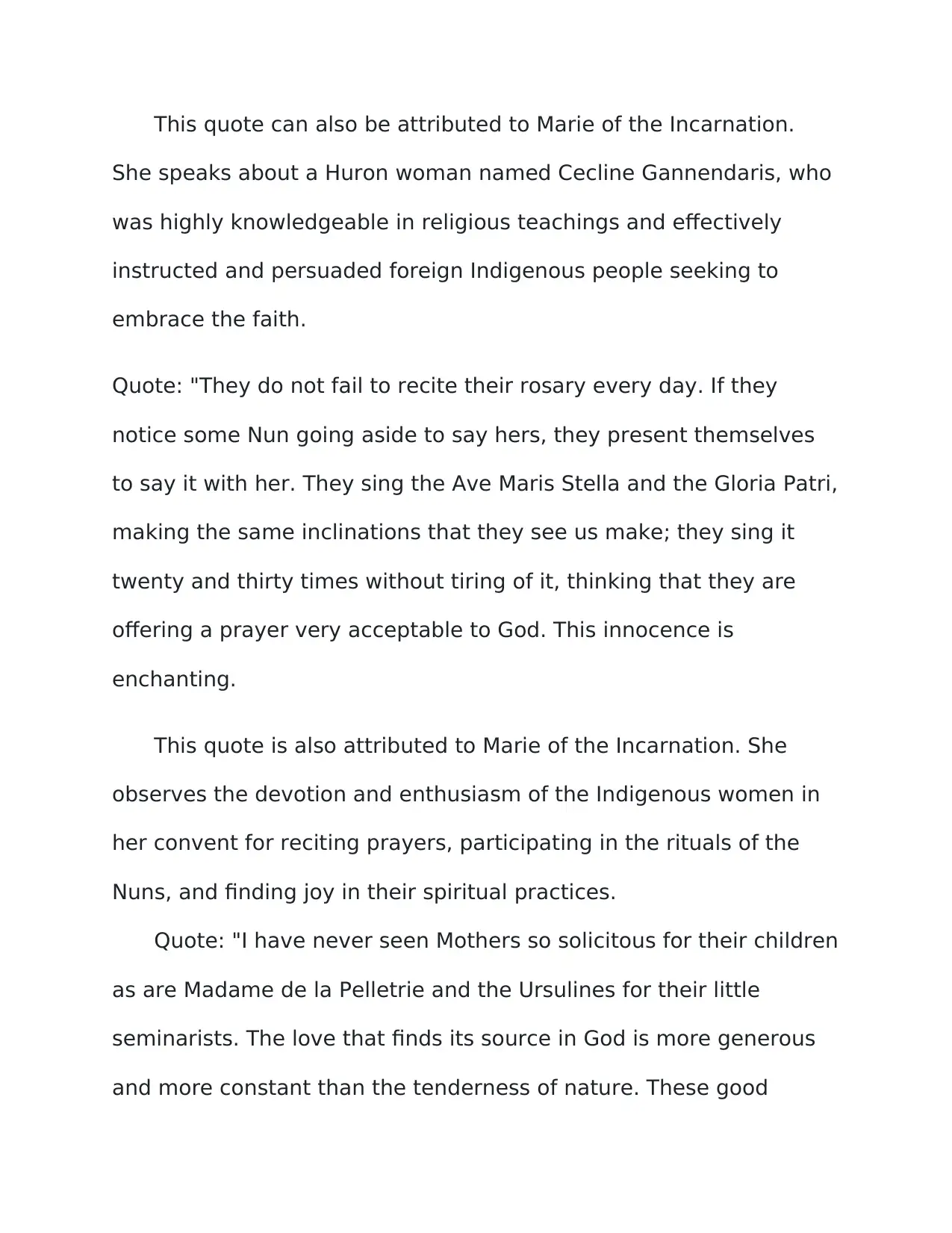
This quote can also be attributed to Marie of the Incarnation.
She speaks about a Huron woman named Cecline Gannendaris, who
was highly knowledgeable in religious teachings and effectively
instructed and persuaded foreign Indigenous people seeking to
embrace the faith.
Quote: "They do not fail to recite their rosary every day. If they
notice some Nun going aside to say hers, they present themselves
to say it with her. They sing the Ave Maris Stella and the Gloria Patri,
making the same inclinations that they see us make; they sing it
twenty and thirty times without tiring of it, thinking that they are
offering a prayer very acceptable to God. This innocence is
enchanting.
This quote is also attributed to Marie of the Incarnation. She
observes the devotion and enthusiasm of the Indigenous women in
her convent for reciting prayers, participating in the rituals of the
Nuns, and finding joy in their spiritual practices.
Quote: "I have never seen Mothers so solicitous for their children
as are Madame de la Pelletrie and the Ursulines for their little
seminarists. The love that finds its source in God is more generous
and more constant than the tenderness of nature. These good
She speaks about a Huron woman named Cecline Gannendaris, who
was highly knowledgeable in religious teachings and effectively
instructed and persuaded foreign Indigenous people seeking to
embrace the faith.
Quote: "They do not fail to recite their rosary every day. If they
notice some Nun going aside to say hers, they present themselves
to say it with her. They sing the Ave Maris Stella and the Gloria Patri,
making the same inclinations that they see us make; they sing it
twenty and thirty times without tiring of it, thinking that they are
offering a prayer very acceptable to God. This innocence is
enchanting.
This quote is also attributed to Marie of the Incarnation. She
observes the devotion and enthusiasm of the Indigenous women in
her convent for reciting prayers, participating in the rituals of the
Nuns, and finding joy in their spiritual practices.
Quote: "I have never seen Mothers so solicitous for their children
as are Madame de la Pelletrie and the Ursulines for their little
seminarists. The love that finds its source in God is more generous
and more constant than the tenderness of nature. These good
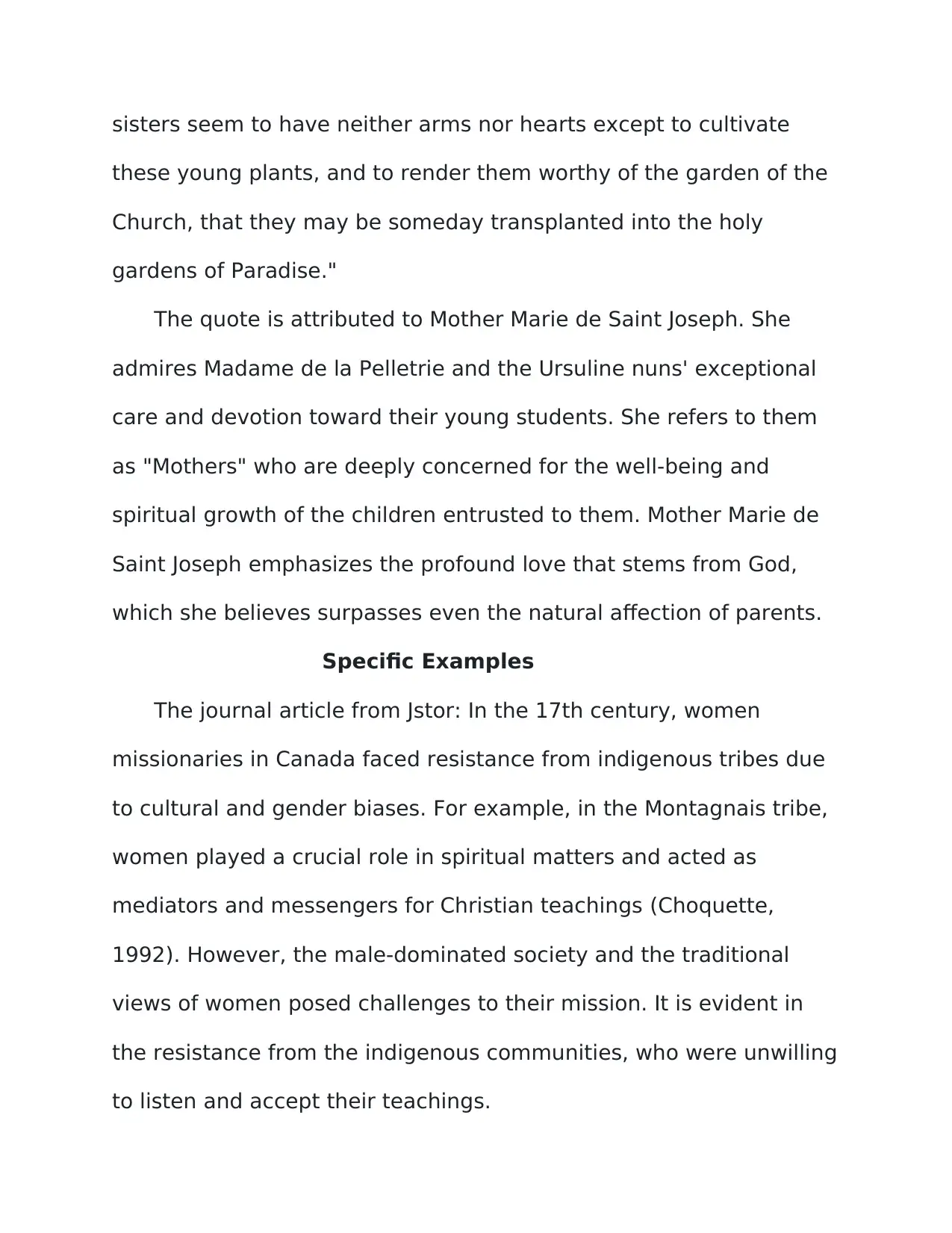
sisters seem to have neither arms nor hearts except to cultivate
these young plants, and to render them worthy of the garden of the
Church, that they may be someday transplanted into the holy
gardens of Paradise."
The quote is attributed to Mother Marie de Saint Joseph. She
admires Madame de la Pelletrie and the Ursuline nuns' exceptional
care and devotion toward their young students. She refers to them
as "Mothers" who are deeply concerned for the well-being and
spiritual growth of the children entrusted to them. Mother Marie de
Saint Joseph emphasizes the profound love that stems from God,
which she believes surpasses even the natural affection of parents.
Specific Examples
The journal article from Jstor: In the 17th century, women
missionaries in Canada faced resistance from indigenous tribes due
to cultural and gender biases. For example, in the Montagnais tribe,
women played a crucial role in spiritual matters and acted as
mediators and messengers for Christian teachings (Choquette,
1992). However, the male-dominated society and the traditional
views of women posed challenges to their mission. It is evident in
the resistance from the indigenous communities, who were unwilling
to listen and accept their teachings.
these young plants, and to render them worthy of the garden of the
Church, that they may be someday transplanted into the holy
gardens of Paradise."
The quote is attributed to Mother Marie de Saint Joseph. She
admires Madame de la Pelletrie and the Ursuline nuns' exceptional
care and devotion toward their young students. She refers to them
as "Mothers" who are deeply concerned for the well-being and
spiritual growth of the children entrusted to them. Mother Marie de
Saint Joseph emphasizes the profound love that stems from God,
which she believes surpasses even the natural affection of parents.
Specific Examples
The journal article from Jstor: In the 17th century, women
missionaries in Canada faced resistance from indigenous tribes due
to cultural and gender biases. For example, in the Montagnais tribe,
women played a crucial role in spiritual matters and acted as
mediators and messengers for Christian teachings (Choquette,
1992). However, the male-dominated society and the traditional
views of women posed challenges to their mission. It is evident in
the resistance from the indigenous communities, who were unwilling
to listen and accept their teachings.
Paraphrase This Document
Need a fresh take? Get an instant paraphrase of this document with our AI Paraphraser
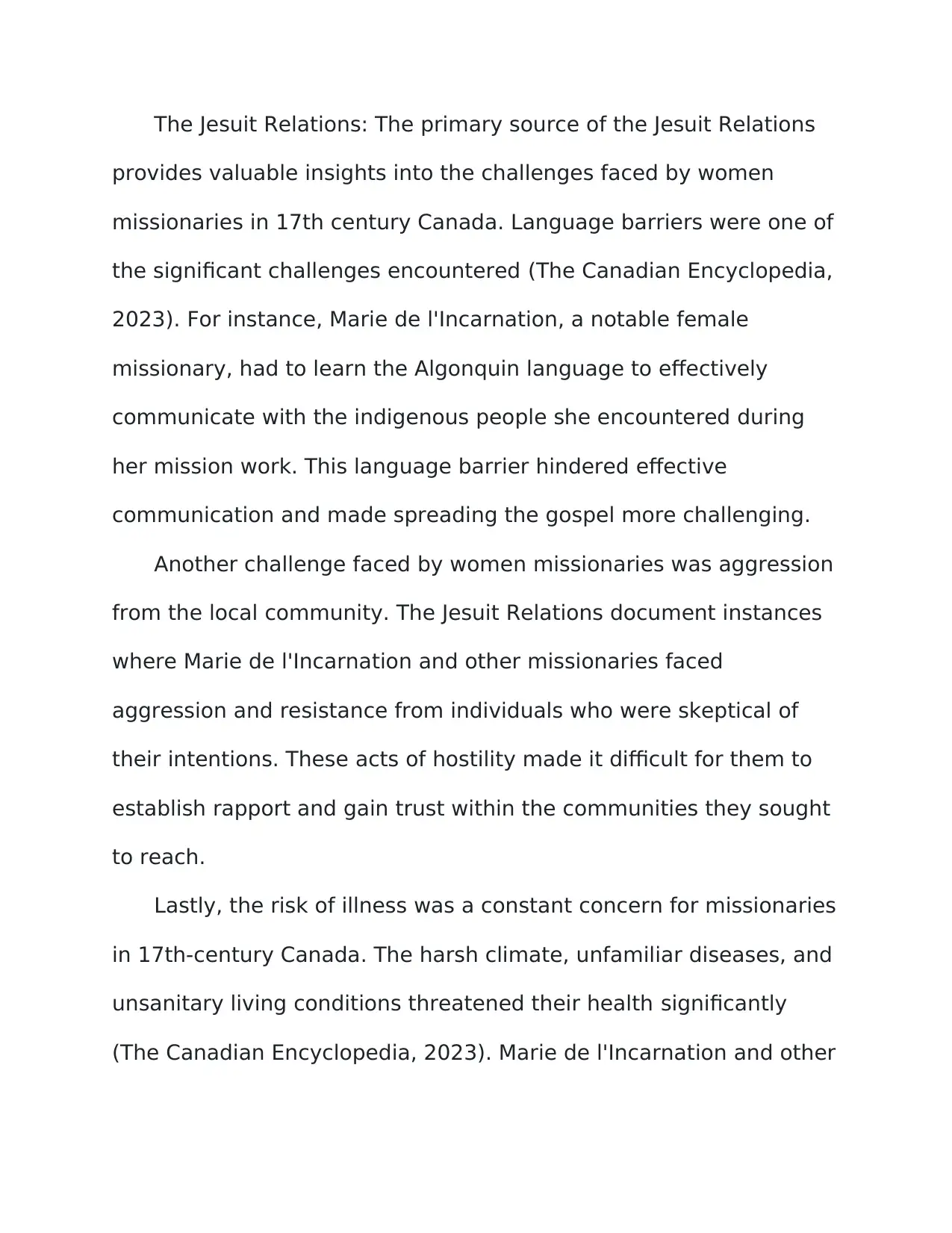
The Jesuit Relations: The primary source of the Jesuit Relations
provides valuable insights into the challenges faced by women
missionaries in 17th century Canada. Language barriers were one of
the significant challenges encountered (The Canadian Encyclopedia,
2023). For instance, Marie de l'Incarnation, a notable female
missionary, had to learn the Algonquin language to effectively
communicate with the indigenous people she encountered during
her mission work. This language barrier hindered effective
communication and made spreading the gospel more challenging.
Another challenge faced by women missionaries was aggression
from the local community. The Jesuit Relations document instances
where Marie de l'Incarnation and other missionaries faced
aggression and resistance from individuals who were skeptical of
their intentions. These acts of hostility made it difficult for them to
establish rapport and gain trust within the communities they sought
to reach.
Lastly, the risk of illness was a constant concern for missionaries
in 17th-century Canada. The harsh climate, unfamiliar diseases, and
unsanitary living conditions threatened their health significantly
(The Canadian Encyclopedia, 2023). Marie de l'Incarnation and other
provides valuable insights into the challenges faced by women
missionaries in 17th century Canada. Language barriers were one of
the significant challenges encountered (The Canadian Encyclopedia,
2023). For instance, Marie de l'Incarnation, a notable female
missionary, had to learn the Algonquin language to effectively
communicate with the indigenous people she encountered during
her mission work. This language barrier hindered effective
communication and made spreading the gospel more challenging.
Another challenge faced by women missionaries was aggression
from the local community. The Jesuit Relations document instances
where Marie de l'Incarnation and other missionaries faced
aggression and resistance from individuals who were skeptical of
their intentions. These acts of hostility made it difficult for them to
establish rapport and gain trust within the communities they sought
to reach.
Lastly, the risk of illness was a constant concern for missionaries
in 17th-century Canada. The harsh climate, unfamiliar diseases, and
unsanitary living conditions threatened their health significantly
(The Canadian Encyclopedia, 2023). Marie de l'Incarnation and other
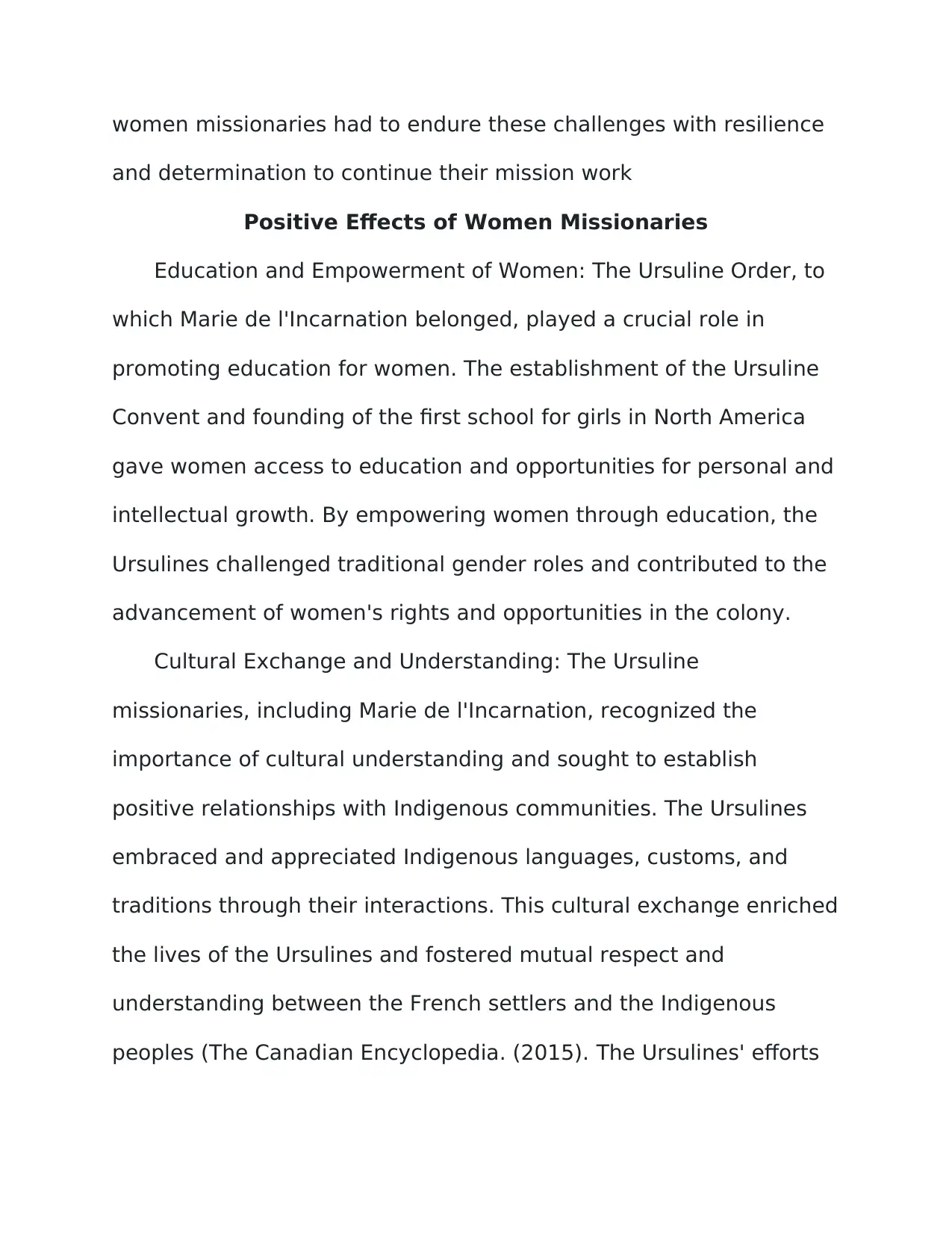
women missionaries had to endure these challenges with resilience
and determination to continue their mission work
Positive Effects of Women Missionaries
Education and Empowerment of Women: The Ursuline Order, to
which Marie de l'Incarnation belonged, played a crucial role in
promoting education for women. The establishment of the Ursuline
Convent and founding of the first school for girls in North America
gave women access to education and opportunities for personal and
intellectual growth. By empowering women through education, the
Ursulines challenged traditional gender roles and contributed to the
advancement of women's rights and opportunities in the colony.
Cultural Exchange and Understanding: The Ursuline
missionaries, including Marie de l'Incarnation, recognized the
importance of cultural understanding and sought to establish
positive relationships with Indigenous communities. The Ursulines
embraced and appreciated Indigenous languages, customs, and
traditions through their interactions. This cultural exchange enriched
the lives of the Ursulines and fostered mutual respect and
understanding between the French settlers and the Indigenous
peoples (The Canadian Encyclopedia. (2015). The Ursulines' efforts
and determination to continue their mission work
Positive Effects of Women Missionaries
Education and Empowerment of Women: The Ursuline Order, to
which Marie de l'Incarnation belonged, played a crucial role in
promoting education for women. The establishment of the Ursuline
Convent and founding of the first school for girls in North America
gave women access to education and opportunities for personal and
intellectual growth. By empowering women through education, the
Ursulines challenged traditional gender roles and contributed to the
advancement of women's rights and opportunities in the colony.
Cultural Exchange and Understanding: The Ursuline
missionaries, including Marie de l'Incarnation, recognized the
importance of cultural understanding and sought to establish
positive relationships with Indigenous communities. The Ursulines
embraced and appreciated Indigenous languages, customs, and
traditions through their interactions. This cultural exchange enriched
the lives of the Ursulines and fostered mutual respect and
understanding between the French settlers and the Indigenous
peoples (The Canadian Encyclopedia. (2015). The Ursulines' efforts
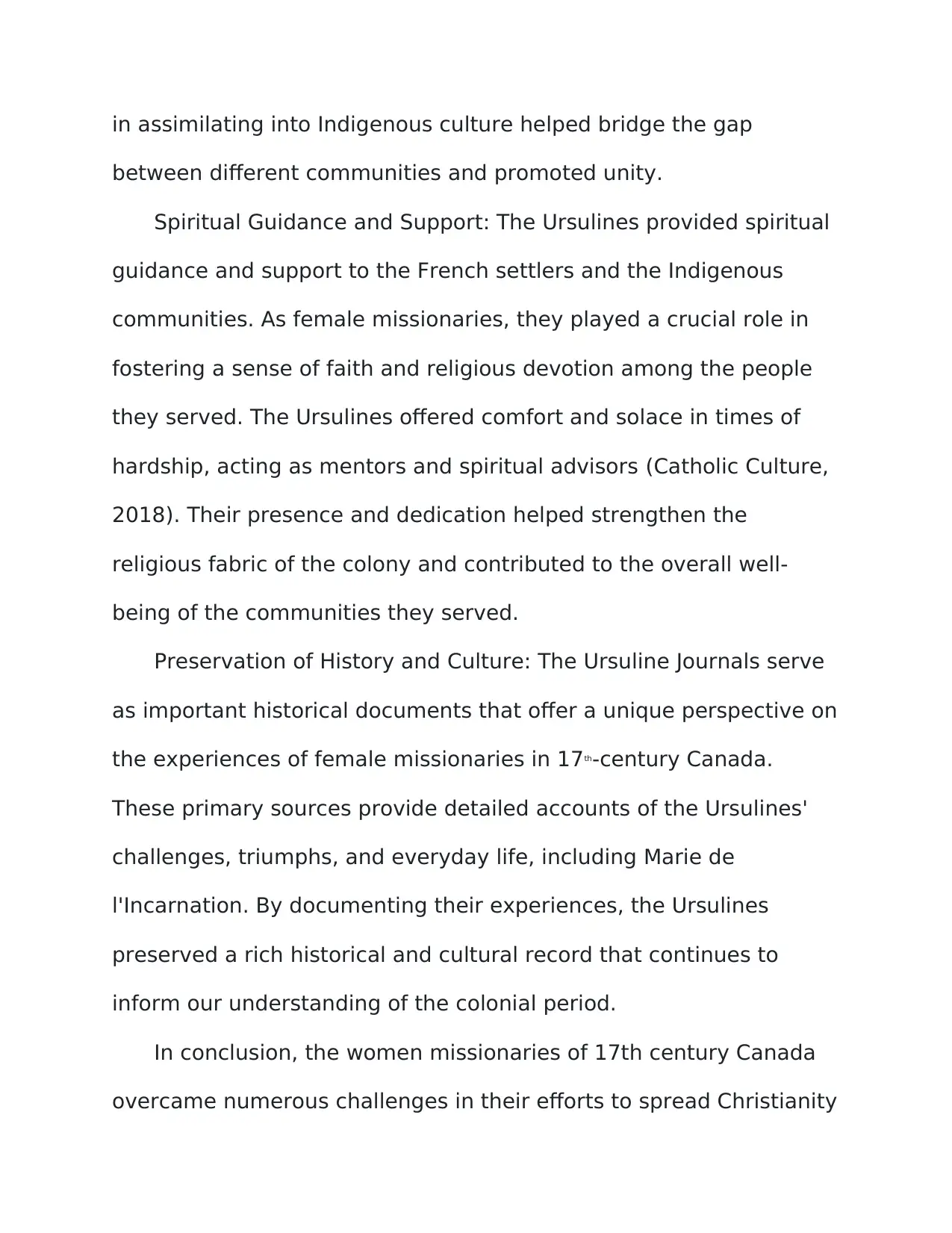
in assimilating into Indigenous culture helped bridge the gap
between different communities and promoted unity.
Spiritual Guidance and Support: The Ursulines provided spiritual
guidance and support to the French settlers and the Indigenous
communities. As female missionaries, they played a crucial role in
fostering a sense of faith and religious devotion among the people
they served. The Ursulines offered comfort and solace in times of
hardship, acting as mentors and spiritual advisors (Catholic Culture,
2018). Their presence and dedication helped strengthen the
religious fabric of the colony and contributed to the overall well-
being of the communities they served.
Preservation of History and Culture: The Ursuline Journals serve
as important historical documents that offer a unique perspective on
the experiences of female missionaries in 17th-century Canada.
These primary sources provide detailed accounts of the Ursulines'
challenges, triumphs, and everyday life, including Marie de
l'Incarnation. By documenting their experiences, the Ursulines
preserved a rich historical and cultural record that continues to
inform our understanding of the colonial period.
In conclusion, the women missionaries of 17th century Canada
overcame numerous challenges in their efforts to spread Christianity
between different communities and promoted unity.
Spiritual Guidance and Support: The Ursulines provided spiritual
guidance and support to the French settlers and the Indigenous
communities. As female missionaries, they played a crucial role in
fostering a sense of faith and religious devotion among the people
they served. The Ursulines offered comfort and solace in times of
hardship, acting as mentors and spiritual advisors (Catholic Culture,
2018). Their presence and dedication helped strengthen the
religious fabric of the colony and contributed to the overall well-
being of the communities they served.
Preservation of History and Culture: The Ursuline Journals serve
as important historical documents that offer a unique perspective on
the experiences of female missionaries in 17th-century Canada.
These primary sources provide detailed accounts of the Ursulines'
challenges, triumphs, and everyday life, including Marie de
l'Incarnation. By documenting their experiences, the Ursulines
preserved a rich historical and cultural record that continues to
inform our understanding of the colonial period.
In conclusion, the women missionaries of 17th century Canada
overcame numerous challenges in their efforts to spread Christianity
Secure Best Marks with AI Grader
Need help grading? Try our AI Grader for instant feedback on your assignments.
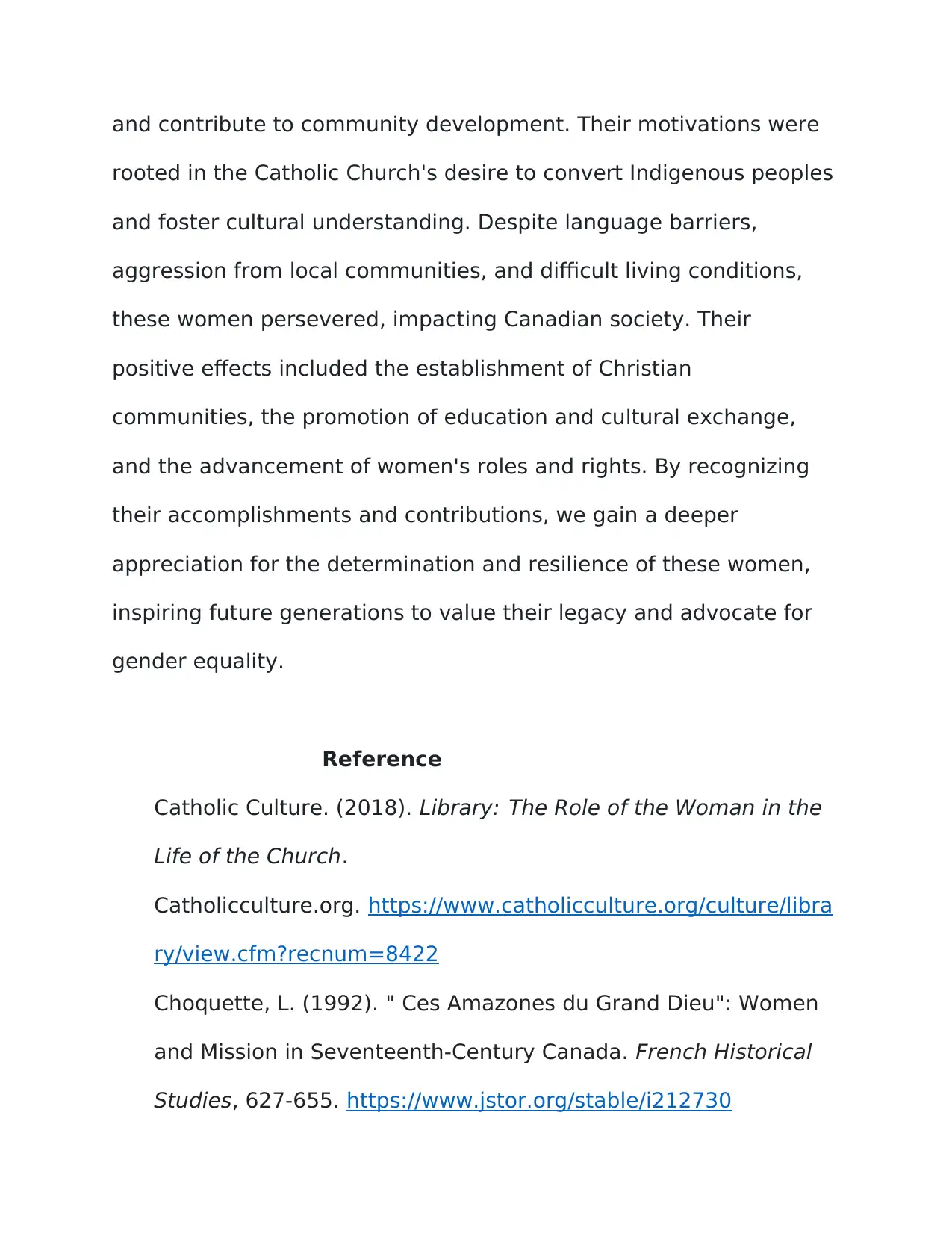
and contribute to community development. Their motivations were
rooted in the Catholic Church's desire to convert Indigenous peoples
and foster cultural understanding. Despite language barriers,
aggression from local communities, and difficult living conditions,
these women persevered, impacting Canadian society. Their
positive effects included the establishment of Christian
communities, the promotion of education and cultural exchange,
and the advancement of women's roles and rights. By recognizing
their accomplishments and contributions, we gain a deeper
appreciation for the determination and resilience of these women,
inspiring future generations to value their legacy and advocate for
gender equality.
Reference
Catholic Culture. (2018). Library: The Role of the Woman in the
Life of the Church.
Catholicculture.org. https://www.catholicculture.org/culture/libra
ry/view.cfm?recnum=8422
Choquette, L. (1992). " Ces Amazones du Grand Dieu": Women
and Mission in Seventeenth-Century Canada. French Historical
Studies, 627-655. https://www.jstor.org/stable/i212730
rooted in the Catholic Church's desire to convert Indigenous peoples
and foster cultural understanding. Despite language barriers,
aggression from local communities, and difficult living conditions,
these women persevered, impacting Canadian society. Their
positive effects included the establishment of Christian
communities, the promotion of education and cultural exchange,
and the advancement of women's roles and rights. By recognizing
their accomplishments and contributions, we gain a deeper
appreciation for the determination and resilience of these women,
inspiring future generations to value their legacy and advocate for
gender equality.
Reference
Catholic Culture. (2018). Library: The Role of the Woman in the
Life of the Church.
Catholicculture.org. https://www.catholicculture.org/culture/libra
ry/view.cfm?recnum=8422
Choquette, L. (1992). " Ces Amazones du Grand Dieu": Women
and Mission in Seventeenth-Century Canada. French Historical
Studies, 627-655. https://www.jstor.org/stable/i212730
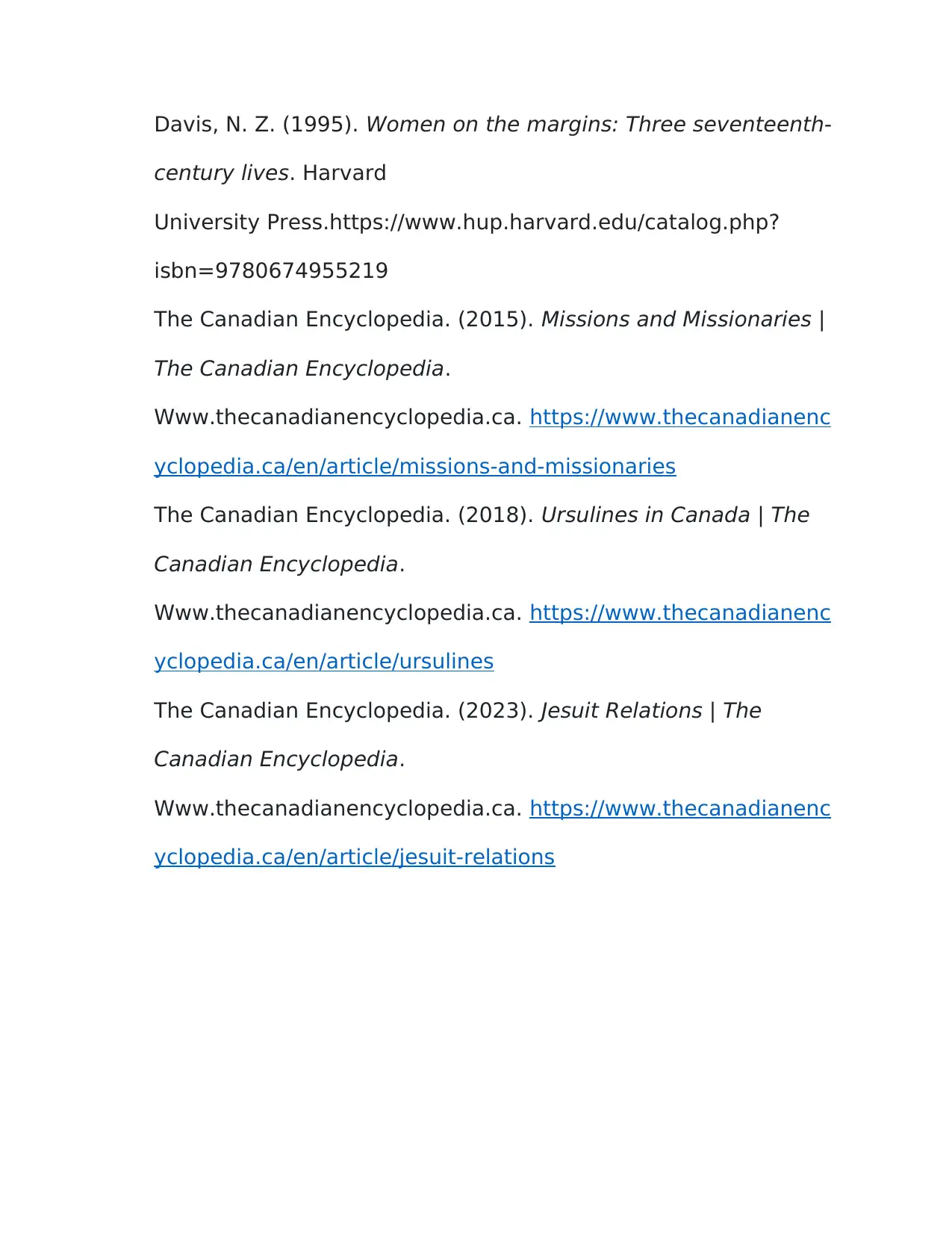
Davis, N. Z. (1995). Women on the margins: Three seventeenth-
century lives. Harvard
University Press.https://www.hup.harvard.edu/catalog.php?
isbn=9780674955219
The Canadian Encyclopedia. (2015). Missions and Missionaries |
The Canadian Encyclopedia.
Www.thecanadianencyclopedia.ca. https://www.thecanadianenc
yclopedia.ca/en/article/missions-and-missionaries
The Canadian Encyclopedia. (2018). Ursulines in Canada | The
Canadian Encyclopedia.
Www.thecanadianencyclopedia.ca. https://www.thecanadianenc
yclopedia.ca/en/article/ursulines
The Canadian Encyclopedia. (2023). Jesuit Relations | The
Canadian Encyclopedia.
Www.thecanadianencyclopedia.ca. https://www.thecanadianenc
yclopedia.ca/en/article/jesuit-relations
century lives. Harvard
University Press.https://www.hup.harvard.edu/catalog.php?
isbn=9780674955219
The Canadian Encyclopedia. (2015). Missions and Missionaries |
The Canadian Encyclopedia.
Www.thecanadianencyclopedia.ca. https://www.thecanadianenc
yclopedia.ca/en/article/missions-and-missionaries
The Canadian Encyclopedia. (2018). Ursulines in Canada | The
Canadian Encyclopedia.
Www.thecanadianencyclopedia.ca. https://www.thecanadianenc
yclopedia.ca/en/article/ursulines
The Canadian Encyclopedia. (2023). Jesuit Relations | The
Canadian Encyclopedia.
Www.thecanadianencyclopedia.ca. https://www.thecanadianenc
yclopedia.ca/en/article/jesuit-relations
1 out of 24
Your All-in-One AI-Powered Toolkit for Academic Success.
+13062052269
info@desklib.com
Available 24*7 on WhatsApp / Email
![[object Object]](/_next/static/media/star-bottom.7253800d.svg)
Unlock your academic potential
© 2024 | Zucol Services PVT LTD | All rights reserved.